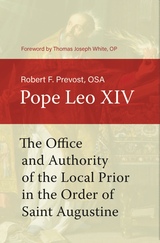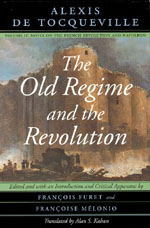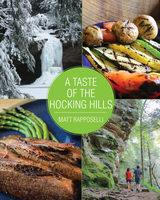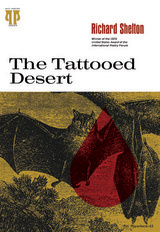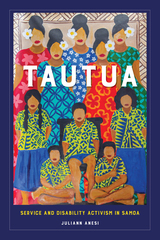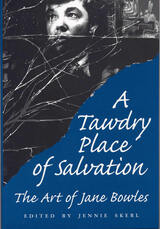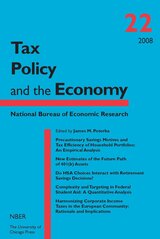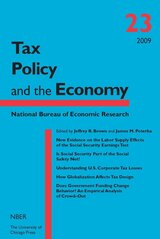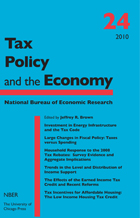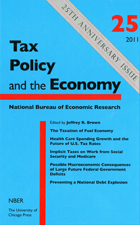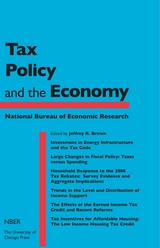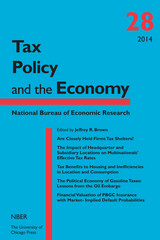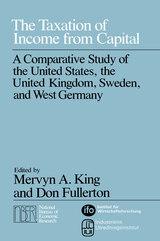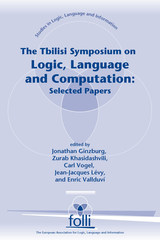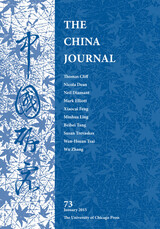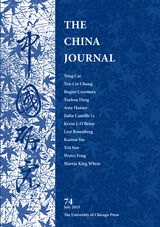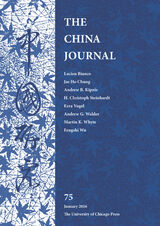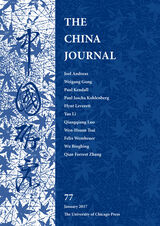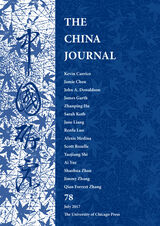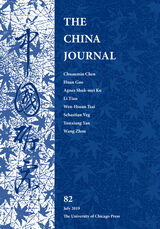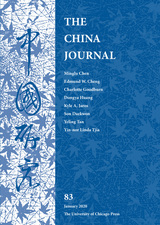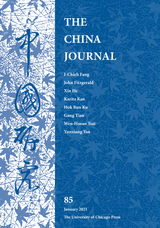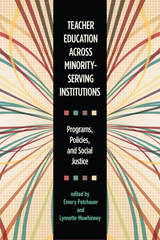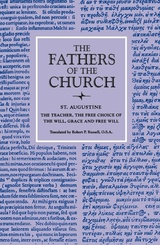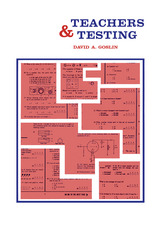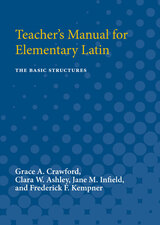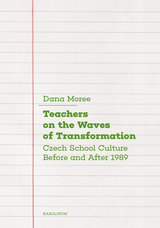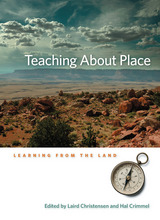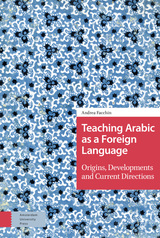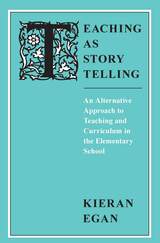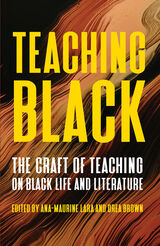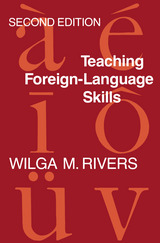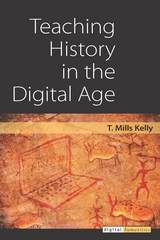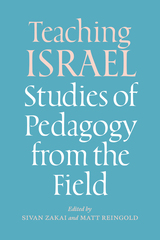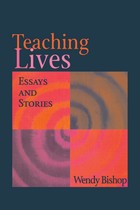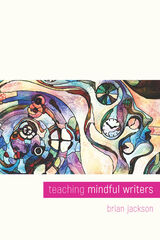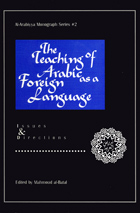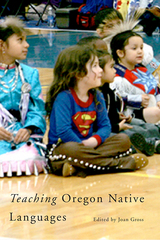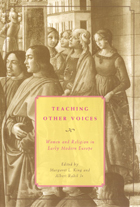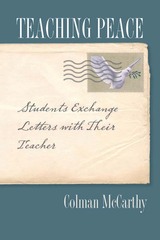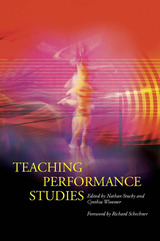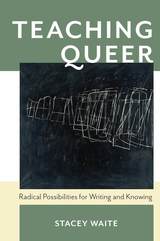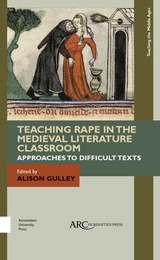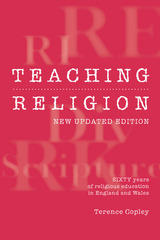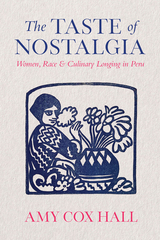 The Taste of Nostalgia: Women, Race, and Culinary Longing in Peru
Amy Cox Hall
University of Texas Press, 2024 An exploration of gender, race, and food in Peru in the 1950s and 1960s and today. From the late 1940s to the mid 1960s, Peru’s rapid industrialization and anti-communist authoritarianism coincided with the rise of mass-produced cookbooks, the first televised cooking shows, glossy lifestyle magazines, and imported domestic appliances and foodstuffs. Amy Cox Hall’s The Taste of Nostalgia uses taste as a thematic and analytic thread to examine the ways that women, race, and the kitchen were foundational to Peruvian longings for modernity, both during the Cold War and today. Drawing on interviews, personal stories, media images, and archival and ethnographic research, Cox Hall considers how elite, European-descended women and the urban home were central to Peru’s modernizing project and finds that all women who labored within the deeply racialized and gendered world of food helped set the stage for a Peruvian food nationalism that is now global in the twenty-first century. Cox Hall skillfully connects how the sometimes-unsavory tastes of the past are served again in today’s profitable and pervasive gastronostalgia that helps sell Peru and its cuisine both at home and abroad.
A Taste of the Hocking Hills
Matt Rapposelli
Ohio University Press, 2018 When chef Matt Rapposelli left the National Park Service to attend culinary school in New England, he was moving from one passion to another. What later brought those passions together was a job in the Hocking Hills, southeast Ohio’s stunning, wild landscape, where the restaurants he helmed—at Hocking Hills Lodge and Lake Hope Lodge—gained a resounding reputation for classic dishes that, driven by the regional vernacular and the natural seasonal abundance of Appalachia, were impeccably fresh and flavorful. A Taste of the Hocking Hills intermingles delicious recipes with striking photographs of a region to which thousands trek each year. Rapposelli presents dishes by the season, noting the specialties that appear on his menus in a given time of year. Whether enjoying a winter evening or a summer morning, cooks will be able to bring a bit of the Hocking Hills home.
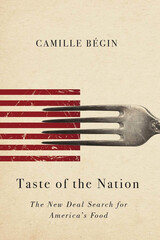 Taste of the Nation: The New Deal Search for America's Food
Camille Bégin
University of Illinois Press, 2016 During the Depression, the Federal Writers' Project (FWP) dispatched scribes to sample the fare at group eating events like church dinners, political barbecues, and clambakes. Its America Eats project sought nothing less than to sample, and report upon, the tremendous range of foods eaten across the United States.
Camille Begin shapes a cultural and sensory history of New Deal-era eating from the FWP archives. From "ravioli, the diminutive derbies of pastries, the crowns stuffed with a well-seasoned paste" to barbeque seasoning that integrated "salt, black pepper, dried red chili powder, garlic, oregano, cumin seed, and cayenne pepper" while "tomatoes, green chili peppers, onions, and olive oil made up the sauce", Begin describes in mouth-watering detail how Americans tasted their food. They did so in ways that varied, and varied widely, depending on race, ethnicity, class, and region. Begin explores how likes and dislikes, cravings and disgust operated within local sensory economies that she culls from the FWP’s vivid descriptions, visual cues, culinary expectations, recipes and accounts of restaurant meals. She illustrates how nostalgia, prescriptive gender ideals, and racial stereotypes shaped how the FWP was able to frame regional food cultures as "American."
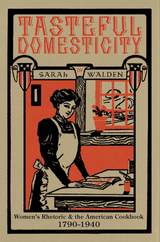 Tasteful Domesticity: Women's Rhetoric and the American Cookbook, 1790-1940
Sarah W. Walden
University of Pittsburgh Press, 2018 Tasteful Domesticity demonstrates how women marginalized by gender, race, ethnicity, and class used the cookbook as a rhetorical space in which to conduct public discussions of taste and domesticity. Taste discourse engages cultural values as well as physical constraints, and thus serves as a bridge between the contested space of the self and the body, particularly for women in the nineteenth century. Cookbooks represent important contact zones of social philosophies, cultural beliefs, and rhetorical traditions, and through their rhetoric, we witness women’s roles as republican mothers, sentimental evangelists, wartime fundraisers, home economists, and social reformers. Beginning in the early republic and tracing the cookbook through the publishing boom of the nineteenth century, the Civil War and Reconstruction, the Progressive era, and rising racial tensions of the early twentieth century, Sarah W. Walden examines the role of taste as an evolving rhetorical strategy that allowed diverse women to engage in public discourse through published domestic texts.
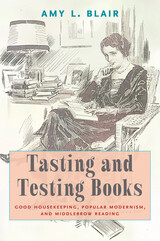 Tasting and Testing Books: Good Housekeeping, Popular Modernism, and Middlebrow Reading
Amy L. Blair
University of Massachusetts Press, 2024 Honorable Mention, 2023-2024 Research Society of American Periodicals Book Prize
In its February 1926 issue, Good Housekeeping magazine introduced a column for its approximately one million subscribers called “Tasting and Testing Books.” The column’s author, Emily Newell Blair, would go on to produce ninety-one reading advice columns for the magazine between 1926 and 1934. During this period, Good Housekeeping became the most widely circulated periodical in the United States, doubling its circulation to over two million copies. Much of its popularity stemmed from its intensive promotion of its Seal of Approval for a variety of products, which brought consumers to it for utilitarian purposes. With her focus on regular books, Blair distinguished herself from highbrow literary critics, many of whom have been objects of study as High Modernists. She offered advice to help middle-class women readers make their own choices about the best books in which to invest time and money, rather than dictating what they should or should not read. She aligns herself with the average subscriber, outside the book publishing and reviewer industries, focusing on books that would now be termed middlebrow reading.
Blair’s time at Good Housekeeping covers the era from the heights of the “Roaring Twenties” to the depths of the Great Depression, and her recommendations offer a window into the uses of middlebrow reading during this period of dramatic economic and social shifts. Tasting and Testing Books argues that the consumer-first message of Good Housekeeping infused Blair’s advice column and validated a new attitude of proudly middlebrow pleasure reading in the mid-twentieth century. These columns shed new light on the reading lives of too-often overlooked women, often living outside of urban centers and away from elite literary circles, and present Emily Newell Blair, who strongly identified with her readers as a truly democratic tastemaker.
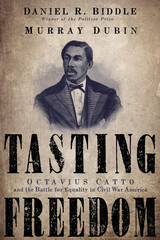 Tasting Freedom: Octavius Catto and the Battle for Equality in Civil War America
Daniel R. Biddle
Temple University Press, 2017 Octavius Valentine Catto was an orator who shared stages with Frederick Douglass, a second baseman on Philadelphia’s best black baseball team, a teacher at the city’s finest black school and an activist who fought in the state capital and on the streets for equal rights. With his racially-charged murder, the nation lost a civil rights pioneer—one who risked his life a century before Selma and Birmingham. In Tasting Freedom Murray Dubin and Pulitzer Prize winner Dan Biddle painstakingly chronicle the life of this charismatic black leader—a “free” black whose freedom was in name only. Born in the American south, where slavery permeated everyday life, he moved north where he joined the fight to be truly free—free to vote, go to school, ride on streetcars, play baseball and even participate in July 4th celebrations. Catto electrified a biracial audience in 1864 when he proclaimed, “There must come a change,” calling on free men and women to act and educate the newly freed slaves. With a group of other African Americans who called themselves a “band of brothers,” they challenged one injustice after another. Tasting Freedom presents the little-known stories of Catto and the men and women who struggled to change America.
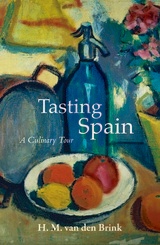 Tasting Spain: A Culinary Tour
H. M. van den Brink
Haus Publishing, 2017 Part travelogue, part memoir, and part cookbook, this addition to the Haus Armchair Traveller series offers a dynamic journey through Spain, one where the focus is on culinary delights found everywhere from Madrid’s cafes to Barcelona’s fish markets.
H. M. van den Brink paints an evocative scene of everyday life in Spain. Readers see the urban shop windows displaying famous serrano ham and Spanish sweet cakes, taste crispy pigs’ ears along with rich chickpea soup, and smell the strong coffee and steaming tortillas often enjoyed while breakfasting outdoors. An appealing blend of historical background and personal recollections, Tasting Spain shapes a lively account of the country and its culture, both in the city and out in the countryside. From exquisite restaurants to private settings, this is a book about eating—meals that Van den Brink has enjoyed solo or with friends—and about the vivid and sustaining memories such meals can create.
“I am not a cook, nor a historian, nor a critic,” writes Van den Brink. “I am just an eater.” With Tasting Spain, he opens new vistas on Spanish cuisine that will tickle the taste buds of readers and leave them hungry for more of this beautiful land.
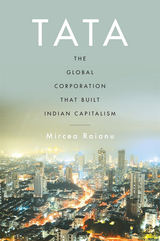 Tata: The Global Corporation That Built Indian Capitalism
Mircea Raianu
Harvard University Press, 2021 An eye-opening portrait of global capitalism spanning 150 years, told through the history of the Tata corporation.
Nearly a century old, the grand façade of Bombay House is hard to miss in the historic business district of Mumbai. This is the iconic global headquarters of the Tata Group, a multinational corporation that produces everything from salt to software. After getting their start in the cotton and opium trades, the Tatas, a Parsi family from Navsari, Gujarat, ascended to commanding heights in the Indian economy by the time of independence in 1947. Over the course of its 150-year history Tata spun textiles, forged steel, generated hydroelectric power, and took to the skies. It also faced challenges from restive workers fighting for their rights and political leaders who sought to curb its power.
In this sweeping history, Mircea Raianu tracks the fortunes of a family-run business that was born during the high noon of the British Empire and went on to capture the world’s attention with the headline-making acquisition of luxury car manufacturer Jaguar Land Rover. The growth of Tata was a complex process shaped by world historical forces: the eclipse of imperial free trade, the intertwined rise of nationalism and the developmental state, and finally the return of globalization and market liberalization. Today Tata is the leading light of one of the world’s major economies, selling steel, chemicals, food, financial services, and nearly everything else, while operating philanthropic institutions that channel expert knowledge in fields such as engineering and medicine.
Based on painstaking research in the company’s archive, Tata elucidates how a titan of industry was created and what lessons its story may hold for the future of global capitalism.
 The Tatars of Crimea: Return to the Homeland
Edward A. Allworth, ed.
Duke University Press, 1998 This new edition of Edward A. Allworth’s The Tatars of Crimea has been extensively updated. Five new chapters examine the situation of Crimean Tatars since the breakup of the USSR in 1991 and detail the continuing struggle of the Tatars to find peace and acceptance in a homeland. Contributors to this volume—almost half of whom are Tatars—discuss the problematic results of the partial Tatar return to Crimea that began in the 1980s. This incomplete migration has left the group geographically split and has complicated their desire for stability as a people, whether in their own homeland or in the Central Asian diaspora. Those who have returned to the region on the Black Sea in Ukrayina (formerly Ukraine) have found themselves engulfed in a hostile political environment dominated by Russian residents attempting to stifle the resurgence of Crimean Tatar life. Specific essays address the current political situation in and around Crimea, recent elections, and promising developments in the culture, leadership, and movement toward unity among Crimean Tatars. Beyond demonstrating the problems of one nationality caught in a fierce power struggle, The Tatars of Crimea offers an example of the challenges faced by all nationalities of the former Soviet Union who now contend with deteriorating economic and political conditions, flagrant discrimination against ethnic minorities, and the denial of civil and human rights common in many of the newly independent states. Contributors. Ludmilla Alexeyeva, Edward A. Allworth, Mübeyyin Batu Altan, Nermin Eren, Alan W. Fisher, Riza Gülüm, Seyit Ahmet Kirimca, Edward Lazzerini, Peter Reddaway, Ayshe Seytmuratova, Andrew Wilson
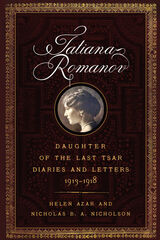 Tatiana Romanov, Daughter of the Last Tsar: Diaries and Letters, 1913–1918
Helen Azar
Westholme Publishing, 2016 Translated for the First Time in English with Annotations by a Leading Expert, the Romanov Family’s Final Years Through the Writings of the Second Oldest Daughter Grand Duchess Tatiana Nikolaevna of Russia was the second of the four daughters of Tsar Nicholas II and his wife, the Empress Alexandra Feodorovna. Long recognized by historians as the undisputed “beauty” of the family, Tatiana was acknowledged for her poise, her elegance, and her innate dignity within her own family. Helen Azar, translator of the diaries of Olga Romanov, and Nicholas B. A. Nicholson, Russian Imperial historian, have joined together to present a truly comprehensive picture of this extraordinarily gifted, complex, and intelligent woman in her own words. Tatiana Romanov, Daughter of the Last Tsar: Diaries and Letters, 1913–1918, presents translations of material never before published in Russian or in English, as well as materials never published in their entirety in the West. The brisk, modern prose of Tatiana’s diary entries reveals the character of a young woman who was far more than the sheltered imperial beauty as she previously has been portrayed. While many historians and writers describe her as a cold, haughty, and distant aristocrat, this book shows instead a remarkably down-to-earth and humorous young woman, full of life and compassion. A detail-oriented and observant participant in some of the most important historical events of the early twentieth century, she left firsthand descriptions of the tercentenary celebrations of the House of Romanov, the early years of Russia’s involvement in World War I, and the road to her family’s final days in Siberian exile. Her writings reveal extraordinary details previously unknown or unacknowledged. Lavishly annotated for the benefit of the nonspecialist reader, this book is not only a reevaluation of Tatiana’s role as more than just one of four sisters, but also a valuable reference on Russia, the First World War, the Russian Revolution, and the people closest to the Grand Duchess and her family.
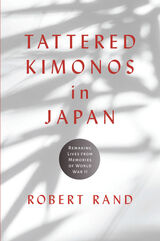 Tattered Kimonos in Japan: Remaking Lives from Memories of World War II
Robert Rand
University of Alabama Press, 2024 Examines Japan’s war generation—Japanese men and women who survived World War Two and rebuilt their lives, into the 21st century, from memories of that conflict
Since John Hersey’s Hiroshima—the classic account, published in 1946, of the aftermath of the atomic bombing of that city—very few books have examined the meaning and impact of World War II through the eyes of Japanese men and women who survived that conflict. Tattered Kimonos in Japan does just that: It is an intimate journey into contemporary Japan from the perspective of the generation of Japanese soldiers and civilians who survived World War II, by a writer whose American father and Japanese father-in-law fought on opposite sides of the conflict.
The author, a former NPR senior editor, is Jewish, and he approaches the subject with the sensibilities of having grown up in a community of Holocaust survivors. Mindful of the power of victimhood, memory, and shared suffering, he travels across Japan, including Hiroshima and Nagasaki, meeting a compelling group of men and women whose lives, even now, are defined by the trauma of war, and by lingering questions of responsibility and repentance for Japan’s wartime aggression.
The image of a tattered kimono from Hiroshima is the thread that drives the narrative arc of this emotional story about a writer’s encounter with history, inside the Japan of his father’s generation, on the other side of his father’s war. This is a book about history with elements of family memoir. It offers a fresh and truly unique perspective for readers interested in World War II, Japan, or Judaica; readers seeking cross-cultural journeys; and readers intrigued by Japanese culture, particularly the kimono.
 Tattoo: Bodies, Art, and Exchange in the Pacific and the West
Nicholas Thomas, Anna Cole, and Bronwen Douglas, eds.
Duke University Press, 2005 The history of tattooing is shrouded in controversy. Citing the Polynesian derivation of the word “tattoo,” many scholars and tattoo enthusiasts have believed that the modern practice of tattooing originated in the Pacific, and specifically in the contacts between Captain Cook’s seamen and the Tahitians. Tattoo demonstrates that while the history of tattooing is far more complex than this, Pacific body arts have provided powerful stimuli to the West intermittently from the eighteenth century to the present day. The essays collected here document the extraordinary, intertwined histories of processes of cultural exchange and Pacific tattoo practices. Art historians, anthropologists, and scholars of Oceania provide a transcultural history of tattooing in and beyond the Pacific. The contributors examine the contexts in which Pacific tattoos were “discovered” by Europeans, track the history of the tattooing of Europeans visiting the region, and look at how Pacific tattooing was absorbed, revalued, and often suppressed by agents of European colonization. They consider how European art has incorporated tattooing, and they explore contemporary manifestations of Pacific tattoo art, paying particular attention to the different trajectories of Samoan, Tahitian, and Maori tattooing and to the meaning of present-day appropriations of tribal tattoos. New research has uncovered a fascinating visual archive of centuries-old tattoo images, and this richly illustrated volume includes a number of those—many published here for the first time—alongside images of contemporary tattooing in Polynesia and Europe. Tattoo offers a tantalizing glimpse into the plethora of stories and cross-cultural encounters that lie between the blood on a sailor’s backside in the eighteenth century and the hammering of a Samoan tattoo tool in the twenty-first. Contributors. Peter Brunt, Anna Cole, Anne D’Alleva, Bronwen Douglas, Elena Govor, Makiko Kuwahara, Sean Mallon, Linda Waimarie Nikora, Mohi Rua, Cyril Siorat, Ngahuia Te Awekotuku, Nicholas Thomas, Joanna White
The Tattooed Desert
Richard Shelton
University of Pittsburgh Press, 1971 Shelton says of his work: "I consider myself a regionalist and a surrealist. I have lived in the desert for ten years and hope that my work reflects that fact." In the forty-seven poems in this collection the poet moves backward and forward through time but always in the same landscape, the desert-mountains of southern Arizona, which foster his surrealistic view of his interior conflict. He is followed by peculiarly insistent voices from the past.
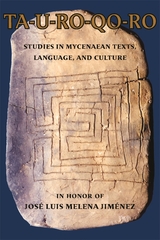 TA-U-RO-QO-RO: Studies in Mycenaean Texts, Language, and Culture in Honor of José Luis Melena Jiménez
Julián Méndez Dosuna
Harvard University Press, 2022 José Luis Melena Jiménez is a peerless scholar of editing the texts written in the Mycenaean writing system of the late second millennium BCE and explicating their linguistic and “historical” contents.
This volume takes up problems of script and language representation and textual interpretation, ranging from the use of punctuation markers and numbers in the Linear B tablets and the values of specific signs, to personal names and place names reflecting the ethnic composition of Mycenaean society and the dialects spoken during the proto-Homeric period of the late Bronze Age. New insights are offered into Mycenaean furniture, war chariots, pictorial vases, land cultivation, arboriculture, and shrine areas. Other papers discuss wealth finance, prestige goods, the ideology of obligatory payment, long-puzzling tax impositions, and the inevitable collapse of the palatial economic and political systems.
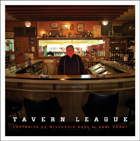 Tavern League: Portraits of Wisconsin Bars
Carl Corey
Wisconsin Historical Society Press, 2011 In Tavern League, photographer Carl Corey documents a unique and important segment of the Wisconsin community. Our bars are unique micro-communities, offering patrons a sense of belonging. Many of these bars are the only public gathering place in the rural communities they serve. These simple taverns offer the individual the valuable opportunity for face to face conversation and camaraderie, particularly as people become more physically isolated through the accelerated use of the internet’s social networking, mobile texting, gaming, and the rapid-fire of email. This collection of 60 pictures captures the Wisconsin tavern as it is today. Carl Corey’s view is both familiar and undeniably unique, his pictures resonant with anyone who has set foot in a Wisconsin tavern. As the Milwaukee Journal Sentinel’s Mary Louise Schumacher has written, “Carl Corey’s photographs . . . document iconic American places that are taken for granted. . . . They are comforting images, places we know, but also eerie and remote, presented with a sense of romance and nostalgia that suggests they are already past.”
A Tawdry Place of Salvation: The Art of Jane Bowles
Edited by Jennie Skerl
Southern Illinois University Press, 1997
Through these essays—which deal with Bowles’s published as well as her unpublished work—Skerl seeks to generate serious critical attention for an important but neglected female experimental writer of the mid-twentieth century and to celebrate her originality, power, and craft.
Based in disciplines and theoretical approaches that range from feminist criticism to Middle Eastern studies, from postmodernism to queer theory, and from Victorianism to the Beat Generation, the essayists naturally approach Bowles’s fiction and drama from a wide variety of critical perspectives. All of these essays are unpublished and written for this volume.
 Tax Expenditures
Stanley S. Surrey and Paul R. McDaniel
Harvard University Press, 1985 When Daniel Webster commented that the two certainties were death and taxes, he could not have imagined all the ingenious ways governments could tax and spend, though leaving this earth has changed not at all.
The tax expenditure concept is one of the newer methods of tax policy analysis that has been reshaping fiscal and monetary plans of governments. A tax expenditure is a financial benefit provided through the tax system. Whether for obsolete machinery in a factory, payment of real estate taxes, or childcare for a working mother, a special tax break is a tax expenditure. The tax expenditure concept was introduced to the Treasury Department in 1968 under the direction of Stanley Surrey and was described in his landmark book Pathways to Tax Reform. In this new book, the authors analyze the development of the concept since 1973, during which time applications of tax expenditures have expanded rapidly and new dimensions have emerged for even wider usage.
The United States prepared special analyses of tax expenditures in 1975 and Congress made the tax expenditure budget a part of the Tax Reform Act of 1981. Other countries now use the tool for analysis and budgeting, and a tax expenditure budget seems to be a permanent fixture in government planning. Recent U.S. tax expenditure budgets have increased by as much as 179 percent, while taxes collected through direct legislation have risen only 14 percent. Surrey and McDaniel focus on the impact of the tax expenditure notion on budget policy and tax policy and administration, and on how governments can decide between tax expenditures or direct spending to implement programs.
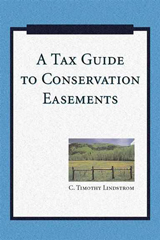 A Tax Guide to Conservation Easements
C. Timothy Lindstrom
Island Press, 2008 Voluntary land conservation, resulting from increasingly alluring tax benefits, has significantly changed the face of land use in the United States and promises to have an even more significant influence in the future. There are more than 1,500 land trusts in the U.S. today, involving millions of acres of land that have been permanently protected by conservation easements. Most of these land trusts depend heavily upon the significant income or estate tax benefits offered by the federal tax code as an incentive for voluntary land conservation. However, only a very small percentage of land trust personnel, landowners or their advisors, or even government officials, fully understand the complexity of the requirements for these tax benefits.
This is a comprehensive book on the tax benefits of the charitable contribution, or bargain sale, of a conservation easement. It provides a detailed explanation of the complex and extensive requirements of the federal tax code and related concepts, including the rules governing the operation of tax-exempt organizations such as land trusts. Clearly written, systematic in its coverage, it is intended to be of value for anyone who deals with land trust issues, including land trust staff and trustees, landowners, lawyers, accountants, government officials, and interested lay people. Structured for easy reference, A Tax Guide to Conservation Easements is designed to be used as a resource tool. Related topics are cross-referenced throughout. All principles in the book are illustrated with one or more useful examples.
The tax benefits of contributing a conservation easement are unquestionably the heart of voluntary land conservation today. Knowledge of the tax law relating to land trusts and conservation easements is vital to properly establishing and managing land trusts and to insuring the tax deductibility of conservation easements. The future of voluntary land conservation is dependent on a clear understanding of tax policy. Complete, meticulous, and up to date, A Tax Guide to Conservation Easements is an essential handbook.
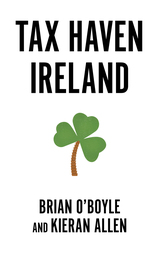 Tax Haven Ireland
Brian O’ Boyle
Pluto Press, 2021 This is the story of how a small island on the edge of Europe became one of the world’s major tax havens. From global corporations such as Apple and Google, to investment bankers and mainstream politicians, those taking advantage of Ireland’s pro-business tax laws and shadow banking system have amassed untold riches at enormous social cost to ordinary people at home and abroad.
Tax Haven Ireland uncovers the central players in this process and exposes the coverups employed by the Irish state, with the help of accountants, lawyers, and financial services companies. From the lucrative internet porn industry to corruption in the property market, this issue distorts the economy across the state and in the wider international system, and its history runs deep, going back the country’s origins as a British colonial outpost.
Today, in the wake of Brexit and in the shadow of yet another economic crash, what can be done to prevent such dangerous behaviour and reorganize our economies to invest in the people? Can Ireland – and all of us – build an alternative economy based on fairness and democratic values?
Tax Policy and the Economy, Volume 22
Edited by James M. Poterba
University of Chicago Press Journals, 2008 Tax Policy and the Economy publishes current academic research findings on taxation and government spending that have both immediate bearing on policy debates and longer-term interest. Volume 22 includes issues related to savings through tax-deferred retirement programs, consumer choice on high-deductible health plans, financial aid applications and the tax filing process, and recent developments in corporate income tax reform in the European Union and possible implications for the United States.
Tax Policy and the Economy, Volume 23
Edited by James M. Poterba
University of Chicago Press Journals, 2009 Tax Policy and the Economy publishes current academic research findings on taxation and government spending that have both immediate bearing on policy debates and longer-term interest. The articles in Volume 23 address a range of topics, including Social Security, understanding corporate tax losses, the influence of globalization on the design of a tax system, and the question of whether federal provision of goods and services crowds out their provision by lower levels of government or the private sector.
Tax Policy and the Economy, Volume 24
Edited by Jefferey R. Brown
University of Chicago Press Journals, 2010 Tax Policy and the Economy publishes current academic research findings on taxation and government spending that have both immediate bearing on policy debates and longer-term interest. The papers in this volume range from topics as broad as the relative efficacy of tax cuts versus spending increases as a form of economic stimulus to a targeted analysis of the Low Income Housing Tax Credit. Also included are two papers at that examine different aspects of policies designed to provide fiscal stimulus, as well as an examination of the effects of recent reforms in the Earned Income Tax Credit.
Tax Policy and the Economy, Volume 25
Edited by Jeffrey R. Brown
University of Chicago Press Journals, 2011 In light of the very public debate on the federal budget this year between Democrats and Republicans, the economic ramifications of tax policy are now more than ever a focus of national attention. Tax Policy and the Economy, Volume 25 is thus an invaluable tool, publishing current academic research findings on taxation and government spending, which informs important policy debates with rigorous economic analysis. The papers in Volume 25 include a review of current fuel economy taxation; research on implicit taxes on work from Social Security and Medicare; an analysis on how future increases in aggregate health care expenditures will impact future tax rates required to support Medicare and Medicaid; and two papers that analyze the implications of large and sustained budget deficits on the economy.
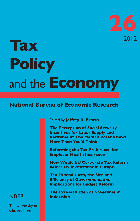 Tax Policy and the Economy, Volume 26
Edited by Jeffrey R. Brown
University of Chicago Press Journals, 2012 There is no question that the US is facing significant fiscal challenges. Tax Policy and the Economy research papers make valuable contributions to our understanding of the economic effects of alternative approaches. The papers collected in Volume 26 include a study of an important determinant of the labor supply effects of Social Security; an examination of the budgetary and economic impact of changing how employer health insurance is treated in the tax code; an analysis of how US investment in Europe might be impacted by proposed corporate tax reform in the European Union; a look at the term “tax expenditures,” often used to describe governmental policies that show as reduction in taxes rather than as an increase in spending. The final paper in the volume shows how uncertainty about the restoration of US fiscal balance imposes additional efficiency costs on the economy in consumption, saving, labor supply and portfolio decisions, and how it reduces individual welfare.
Tax Policy and the Economy, Volume 27
Edited by Jeffrey R. Brown
University of Chicago Press Journals, 2013 Taxation policy was a central part of the policy debates over the “fiscal cliff.” Given the importance of fiscal issues, it is vital for rigorous empirical research to inform the policy dialogue. In keeping with the NBER’s tradition of carrying out rigorous but policy-relevant research, Volume 27 of Tax Policy and the Economy offers insights on a number of key tax policy questions. This year's volume features six papers by leading scholars who examine the tax treatment of tuition at private K-12 schools, the potential streamlining of the federal rules for post-secondary financial aid and the use of tax return information in this process, the effect of tax and benefit programs on incentives to work, the macroeconomic effects of fiscal adjustments, and the set of factors that contributed to the weakening US fiscal outlook in the last decade.
Tax Policy and the Economy, Volume 28
Edited by Jeffrey R. Brown
University of Chicago Press Journals, 2014 The papers in Volume 28 of Tax Policy and the Economy illustrate the depth and breadth of the research by NBER research associates who study taxation and government spending programs. The first paper explores whether closely held firms are used as tax shelters. The second examines the taxation of multinational corporations. The third discusses the taxation of housing, focusing on the ways in which current income tax rules may affect location and consumption decisions and lead to economic inefficiencies. The fourth paper offers an historical perspective on the political economy of gasoline taxes, with a particular focus on the response to the oil shocks of the early 1970s. The fifth and final paper uses the tools of financial economics to estimate the unfunded liabilities of the Pension Benefit Guaranty Corporation.
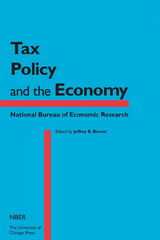 Tax Policy and the Economy, Volume 29
Edited by Jeffrey R. Brown
University of Chicago Press Journals, 2016 The papers in Volume 29 of Tax Policy and the Economy illustrate the depth and breadth of the taxation-related research by NBER research associates, both in terms of methodological approach and in terms of topics. In the first paper, former NBER President Martin Feldstein estimates how much revenue the federal government could raise by limiting tax expenditures in various ways, such as capping deductions and exclusions. The second paper, by George Bulman and Caroline Hoxby, makes use of a substantial expansion in the availability of education tax credits in 2009 to study whether tax credits have a significant causal effect on college attendance and related outcomes. In the third paper, Casey Mulligan discusses how the Affordable Care Act (ACA) introduces or expands taxes on income and on full-time employment. In the fourth paper, Bradley Heim, Ithai Lurie, and Kosali Simon focus on the “young adult” provision of the ACA that allows young adults to be covered by their parents’ insurance policies. They find no meaningful effects of this provision on labor market outcomes. The fifth paper, by Louis Kaplow, identifies some of the key conceptual challenges to analyzing social insurance policies, such as Social Security, in a context where shortsighted individuals fail to save adequately for their retirement.
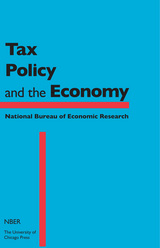 Tax Policy and the Economy, Volume 30
Edited by Jeffrey R. Brown
University of Chicago Press Journals, 2016 The research papers in Volume 30 of Tax Policy and the Economy make significant contributions to the academic literature in public finance and provide important conceptual and empirical input to policy design. In the first paper, Gerald Carlino and Robert Inman consider whether state-level fiscal policies create spillovers for neighboring states and how federal stimulus can internalize these externalities. The second paper, by Nathan Hendren, presents a new framework for evaluating the welfare consequences of tax policy changes and explains how the key parameters needed to implement this framework can be estimated. The third paper, a collaborative effort by several academic and US Treasury economists, documents the dramatic increase in pass-through businesses, including partnerships and S-corporations, over the last thirty years. It notes that these entities now generate more than half of all US business income. The fourth paper examines property tax compliance using a pseudo-randomized experiment in Philadelphia, in which those who owed taxes received supplemental letters regarding their tax delinquency. The research explores what types of communication lead to higher rates of tax payment. In the fifth paper, Jeffrey Clemens discusses cross-program budgetary spillovers of minimum wage regulations. Severin Borenstein and Lucas Davis, the authors of the sixth paper, study the distributional effects of income tax credits for clean energy.
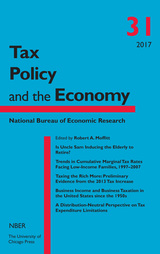 Tax Policy and the Economy, Volume 31
Edited by Robert A. Moffitt
University of Chicago Press Journals, 2017 The papers in Tax Policy and the Economy Volume 31 are all directly related to important and often long-standing issues, often including how transfer programs affect tax rates and behavior. In the first paper, Alan Auerbach, Laurence Kotlikoff, Darryl Koehler, and Manni Yu take a lifetime perspective on the marginal tax rates facing older individuals and families arising from a comprehensive set of sources. In the second, Gizem Kosar and Robert A. Moffitt provide new estimates of the cumulative marginal tax rates facing low-income families over the period 1997-2007. In the third paper, Emmanuel Saez presents evidence on the elasticity of taxable income with respect to tax rates, drawing on data from the 2013 federal income tax reform. In the fourth, Conor Clarke and Wojciech Kopczuk survey the treatment of business income taxation in the United States since the 1950s, providing new data on how business income and its taxation have evolved over time. In the fifth paper, Louis Kaplow argues that the reduction in statutory tax rates from base-broadening may not reduce effective marginal tax rates on households.
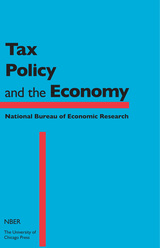 Tax Policy and the Economy: Volume 32
Edited by Robert A. Moffitt
University of Chicago Press Journals, 2018 The six research studies in Volume 32 of Tax Policy and the Economy analyze the U.S. tax and transfer system, in particular its effects on revenues, expenditures, and economic behavior. First, James Andreoni examines donor advised funds, which are financial vehicles offered by investment houses to provide savings accounts for tax-free charitable giving, and weighs their effects on donations against their tax cost. Second, Caroline Hoxby analyzes the use of tax credits by students enrolled in online post-secondary education. Third, Alex Rees-Jones and Dmitry Taubinsky explore taxpayers’ psychological biases that lead to incorrect perceptions and understanding of tax incentives. Fourth, Jeffrey Clemens and Benedic Ippolito investigate the implications of block grant reforms of Medicaid for receipt of federal support by different states. Fifth, Andrew Samwick examines means-testing of Medicare and federal health benefits under the Affordable Care Act. Sixth, Bruce Meyer and Wallace Mok study the incidence and effects of disability among U.S. women from 1968 to 2015, examining the impacts of disability on income, consumption, and public transfers.
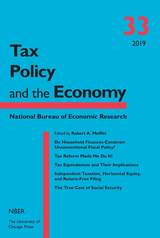 Tax Policy and the Economy, Volume 33
Edited by Robert A. Moffitt
University of Chicago Press Journals, 2019 This volume presents five new studies on taxation and government transfer programs. Alexander Blocker, Laurence Kotlikoff, Stephen Ross, and Sergio Villar Vallenas show how asset pricing can be used to value implicit fiscal debts, which are currently rarely measured or adjusted for risk, while accounting for risk properties. They apply their methodology to study Social Security. Michelle Hanson, Jeffrey Hoopes, and Joel Slemrod examine the effects of the Tax Cuts and Jobs Act on corporation behavior and on firms’ statements about their behavior. They focus on for four outcomes: bonuses, investment, share repurchases, and dividends. Scott Baker, Lorenz Kueng, Leslie McGranahan, and Brian Melzer explore whether “unconventional” fiscal policy in the form of pre-announced consumption tax changes can shift durables purchases intertemporally, how it such shifts are affected by consumer credit. Alan Auerbach discusses “tax equivalences,” disparate sets of policies that have the same economic effects, and also illustrates when these equivalences break down. Jeffrey Liebman and Daniel Ramsey use data from NBER’s TAXSIM model to investigate the equity implications of a switch from joint to independent taxation that could occur in conjunction with adoption of return-free tax filing.
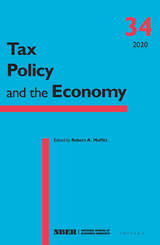 Tax Policy and the Economy, Volume 34
Edited by Robert A. Moffitt
University of Chicago Press Journals, 2020 This volume presents five new studies on current topics in taxation and government spending. Mark Shepard, Katherine Baicker, and Jonathan Skinner explore implementation aspects of a Medicare-for-All program, which provides a uniform health insurance benefit to everyone, and contrast it with a program providing a basic benefit that can be supplemented voluntarily. John Beshears, James Choi, Mark Iwry, David John, David Laibson, and Brigitte Madrian examine the design and feasibility of firm-sponsored “rainy day funds,” short-term savings accounts for employees that can be used when faced with temporary periods of high expenditure. Robert Barro and Brian Wheaton investigate the impact of taxation on choice of corporate form, on the formation and legal structure of new businesses, and indirectly on productivity in the economy. Jonathan Meer and Benjamin Priday examine the impact of the 2017 federal income tax reform, which reduced marginal tax rates and the incentive for charitable giving, on such giving. Finally, Casey Mulligan analyzes the impact of the Affordable Care Act on whether firms employ fewer than 50 employees, the employment threshold below which they are exempt from the requirement to provide health insurance to their employees.
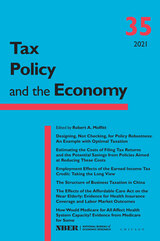 Tax Policy and the Economy, Volume 35
Edited by Robert A. Moffitt
University of Chicago Press Journals, 2021 This volume presents six new studies on current topics in taxation and government spending. The first study looks at the costs of income tax filing, which have risen over time because of the numerous tax forms families have to fill out when filing their taxes and because of increased costs of itemizing deductions, and explores ways to simplify filing and reduce those costs. The second study investigates the design of income tax schedules when there is uncertainty about the way taxation affects household behavior. The third study provides new and comprehensive estimates of the impact of the US Earned Income Tax Credit on the employment of low-income men and women, finding that the large majority of the various expansions of that credit over the last forty years have increased employment of single mothers. The fourth study reviews the structure of business taxation in China and describes a number of tax distortions and potential inefficiencies in the system. The next paper considers how the Affordable Care Act has affected the health insurance and labor market choices of individuals who are between the ages of 60 and 64, and it finds increases in insurance coverage and reductions in employment for some groups. The last study considers how reimbursement rates for health care providers under various government insurance programs affect providers’ willingness to take on new patients and expand their patient capacity.
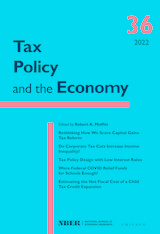 Tax Policy and the Economy, Volume 36
Edited by Robert A. Moffitt
University of Chicago Press Journals, 2022 This volume presents five new studies on current topics in taxation and government spending.
Natasha Sarin, Lawrence Summers, Owen Zidar, and Eric Zwick study how investors respond to taxes on capital gains, whether their incentives to invest are affected by those taxes, and whether that responsiveness has changed over time. Ethan Rouen, Suresh Nallareddy, and Juan Carlos Suárez Serrato revisit the question of whether cuts to corporate taxes increase income inequality, bringing new data and new statistical techniques to generate fresh findings. Alan Auerbach and William Gale investigate whether the advantages and disadvantages of different types of taxation are affected when interest rates stay low for long periods, as has been the case in the U.S. for many years. Nora Gordon and Sarah Reber study the distributional impact of emergency subsidies to schools made by the federal government during the recent COVID pandemic and whether those subsidies were sufficient to cover the increased school costs induced by the pandemic. Jacob Goldin, Elaine Maag, and Katherine Michelmore investigate the fiscal cost of an expansion of the U.S. child tax credit, which has been discussed extensively in policy circles recently. They take into account not only the direct expenditure on the allowance but how cost is affected by the existence of work incentives and by possible beneficial effects on childrens’ adult earnings.
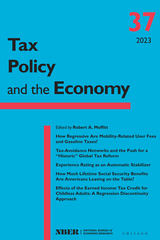 Tax Policy and the Economy, Volume 37
Edited by Robert A. Moffitt
University of Chicago Press Journals, 2023 Timely and authoritative research on the latest issues in tax policy.
Tax Policy and the Economy publishes current academic research on taxation and government spending with both immediate bearing on policy debates and longer-term interest.
This volume of Tax Policy and the Economy presents new research on important issues concerning US taxation and transfers. First, Edward L. Glaeser, Caitlin S. Gorback, and James M. Poterba examine the distribution of burdens associated with taxes on transportation. Replacing the gasoline tax with a vehicle-miles-traveled (VMT) tax would increase the burden on higher-income households, who drive more fuel-efficient cars and are more likely to own electric vehicles. User charges for airports, subways, and commuter rail are progressive, while the burden of bus fees is larger for lower-income households than for their higher-income counterparts. Next, Katarzyna Bilicka, Michael Devereux, and Irem Güçeri investigate tax shifting by multinational companies (MNCs) and the implications of a potential Global Minimum Tax (GMT). They find that MNCs shift intellectual property to tax havens, and that a large share of patenting activity takes place in tax havens where little or no R&D occurs. Tax havens are particularly important for MNCs with large subsidiary networks; such firms would likely be subject to a GMT. Mark Duggan, Audrey Guo, and Andrew C. Johnston study the role of experience rating in the Unemployment Insurance (UI) system and find that the current structure stabilizes the labor market because it penalizes firms with high rates of UI-eligible layoffs. In the fourth paper, David Altig, Laurence J. Kotlikoff, and Victor Yifan Ye calculate how retiring at different ages will affect Social Security benefit amounts, taking into account taxation and other benefits. They find that virtually all individuals aged 45 to 62 should wait until age 65 or later to maximize their Social Security benefits. Indeed, 90 percent would benefit from waiting until age 70, but only 10 percent do so. Finally, Jonathan Meer and Joshua Witter examine the potential impact of the Earned Income Tax Credit on the labor force decisions of childless adults who are eligible for a small credit after they reach age 25. Comparing labor force attachment changes just before and after this age suggests that the EITC has little impact on the labor force participation of this group.
 Tax Policy and the Economy, Volume 38
Edited by Robert A. Moffitt
University of Chicago Press Journals, 2024 Timely and authoritative research on the latest issues in tax policy.
Tax Policy and the Economy publishes current academic research on taxation and government spending with both immediate bearing on policy debates and longer-term interest.
This volume presents new research on taxation and public expenditure programs, with particular focus on how they affect economic behavior. John Guyton, Kara Leibel, Dayanand Manoli, Ankur Patel, Mark Payne, and Brenda Schafer study the disallowance of Earned Income Tax Credit (EITC) benefits as a result of IRS audits, and find that in post-audit years, audited taxpayers are less likely than similar non-audited taxpayers to claim EITC benefits. Janet Holtzblatt, Swati Joshi, Nora Cahill, and William Gale provide new empirical evidence on racial differences in the income tax penalty, or bonus, associated with a couple being married. Haichao Fan, Yu Liu, Nancy Qian, and Jaya Wen evaluate how computerizing value-added tax transactions in China affected the tax revenue collected from large manufacturing firms. Niels Johannesen, Daniel Reck, Max Risch, Joel Slemrod, John Guyton, and Patrick Langetieg study data on the ownership of foreign bank accounts and other financial accounts as reported on income tax returns. They find that many of these accounts are in tax havens, and they discuss the impact of the Foreign Account Tax Compliance Act on tax compliance and government revenue. Louis Kaplow integrates charitable giving into an optimal income tax framework, and shows that the externalities associated with such giving are key to determining its optimal tax treatment. Finally, Roger Gordon compares caps or quantity targets on emissions with carbon taxes and points out that which one dominates can be situation-specific and depend on a number of features of the economy.
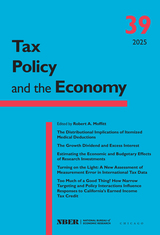 Tax Policy and the Economy, Volume 39
Edited by Robert A. Moffitt
University of Chicago Press Journals, 2025 Timely and authoritative research on the latest issues in tax policy.
Tax Policy and the Economy publishes current academic research on taxation and government spending with both immediate bearing on policy debates and longer-term interest. This volume highlights new insights on taxation, transfer programs, and related issues. First, analyzing the itemized medical deduction in the US federal income tax, Gopi Shah Goda, Ithai Lurie, Priyanka Parikh, and Chelsea Swete find that this provision disproportionately benefits higher-income taxpayers, particularly after the passage of the 2017 Tax Cuts and Jobs Act. They also consider alternative structures, such as a tax credit, that could make the distribution of the tax benefits for those with high medical outlays more equal. Next, Danny Yagan analyzes factors influencing the US federal budget deficit and the debt-to-GDP ratio. He describes the "growth dividend," the impact of GDP growth on the debt ratio, and warns about the potential costs of high debt-to-GDP ratios, especially when interest rates rise. In the third paper, Theresa Gullo, Benjamin Page, David Weiner, and Heidi Williams synthesize the economic evidence on the economic and budgetary effects of R&D investment and examine how this evidence could be incorporated into the standard projections generated by various federal agencies. Fourth, Rosanne Altshuler, Lysle Boller, and Juan Carlos Suárez Serrato investigate profit shifting by US multinational corporations and evaluate the importance of aggregation errors in reported foreign earnings and on estimates of profit shifting elasticities based on these data. Finally, David Neumark and Zeyu Li find no employment effect of California’s Earned Income Tax Credit on less-skilled single mothers, in contrast with the effects of federal and other states' programs. They suggest that structural differences and interactions with minimum wage laws explain this result.
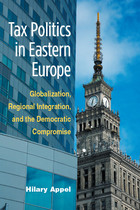 Tax Politics in Eastern Europe: Globalization, Regional Integration, and the Democratic Compromise
Hilary Appel
University of Michigan Press, 2011 “This is the first book to systematically examine the variation in policies of Eastern European countries. There is a theoretical contribution to understandings of variation in tax policies, but just as impressive is the in-depth empirical analysis and in particular the data from interviews with key players in the process.”
—Yoshiko Herrera, University of Wisconsin-Madison Post-Communist tax reform, like institutional reform in other areas of the post-Communist transition, holds tremendous material consequences for different groups in society. Consequently, one would expect the allocation of resources and the distribution of the financial burden of that allocation to be highly sensitive to domestic politics. Indeed the political stakes should be especially high since post-Communist tax reform requires not merely a simple adjustment at the margin, but the fundamental reallocation of the responsibility for government revenue. In Eastern Europe, however, important areas of tax policy do not reflect traditional domestic variables (e.g., interest groups and partisanship) so much as the international imperatives associated with regional and global economic integration. In Tax Politics in Eastern Europe, Hilary Appel analyzes the domestic and international factors that drive tax policy. She begins with a review of the greatest challenges in the initial creation of the capitalist tax systems in former Communist states and then turns to the evolution of specific forms of taxation in order to gauge the relative impact of domestic politics on tax policy. Appel concludes that, although some tax areas, such as personal income taxes, remain politicized, most other taxes, such as corporate income taxes and all forms of consumption taxes, have been less subject to domestic political pressures because of powerful constraints resulting from regional and global economic integration.
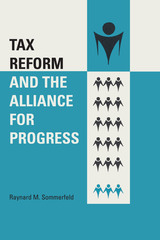 Tax Reform and the Alliance for Progress
By Raynard M. Sommerfeld
University of Texas Press, 1966 The Alliance for Progress was a program intended to stimulate and aid the economic development of the peoples of Latin America. It proposed that the United States and nineteen Latin American republics pool financial and technical resources to aid the peoples of all these republics in achieving better living standards, greater human dignity, and increased political freedom. Although achievement of these goals depended partially upon the availability of external assistance, it depended even more upon the ability and willingness of the Latin Americans themselves to make numerous far-reaching institutional reforms within their countries. One of the most important needs was in the area of tax reform, which had been made a quid pro quo for the twenty billion dollars promised by the United States through the program. This limitation upon the use of United States funds made obvious the need for a means of evaluating the adequacy of Latin American tax-reform efforts. In this study Raynard M. Sommerfeld presents an examination of this problem and recommends basic criteria for such evaluation. The study reviews the objectives of the Alliance for Progress, investigates the prevailing tax systems in the Latin American republics, and offers recommendations for tax-reform efforts to harmonize tax policy with the economic development goals stipulated in the Charter of Punta del Este. The author emphasizes and reiterates the fact that thorough studies of the individual countries are necessary for the planning of truly adequate tax reform. He offers the facts developed in his study as interim tools for United States Alliance for Progress agencies in evaluating Latin American tax-reform efforts, for Latin American planners seeking to guide their countries most easily on the road to economic maturity, and for all scholars, teachers, and students interested in the fields of Latin American economics, taxation, and political history.
Tax Reform in Developing Countries
Malcolm Gillis, ed.
Duke University Press, 1989 This volume presents the work of experts (in most cases the very advisers who designed and helped implement the reforms) on the tax reform efforts of a dozen developing nations—from the restructuring of the economy of postwar Japan to the 1986 reforms in Jamaica. Among the many lessons learned from these efforts are that tax reform is most successful when tax administration is a central (rather than peripheral) focus of reform efforts, and when tax reform is specifically directed toward economic rather than noneconomic objectives.
Other conclusions include the apparently mutually reinforcing nature of tax simplification and tax rate reduction, and the role of indirect tax reforms (such as the value-added tax) in successful reform undertakings.
 Tax Revolt: Something for Nothing in California
David O. Sears and Jack Citrin
Harvard University Press, 1982 A tax revolt almost as momentous as the Boston Tea Party erupted in California in 1978. Its reverberations are still being felt, yet no one is quite sure what general lessons can be drawn from observing its course. This book is an in-depth study of this most recent and notable taxpayers' rebellion: Howard Jarvis and Proposition 13, the Gann measure of 1979, and Proposition 9 (Jarvis II) of 1980. The people of California, speaking directly through referenda, redirected their state from an intense and expensive concern for the welfare of its citizens to a far more circumspect role. The sequence involved cutting property taxes, limiting tax growth, and then rejecting a state income tax cut.
Why did Californians vote to lower some taxes and not others? How fundamental is the American disposition toward tax revolt? Will it happen again? The authors consider a variety of partial answers: the self-interest of certain groups, the apathy of others, the role of party affiliation, the specter of symbolic racism, the meaning of mass mood surges. The interplay between class politics and symbolic protest embodied in the California Tax Revolt has since spread to other states—for example, Proposition 21/2 in Massachusetts, which lowered property taxes—and has reached the federal level. President Reagan, with Republican and conservative Democrat support, has enacted major spending cuts and long-range tax relief. The new revolutionary strand in the fabric of the American political culture appears to be strong.
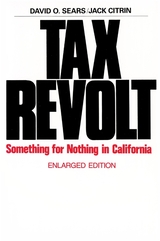 Tax Revolt: Something for Nothing in California, Enlarged Edition
David O. Sears and Jack Citrin
Harvard University Press, 1985 A tax revolt almost as momentous as the Boston Tea Party erupted in California in 1978. Its reverberations are still being felt, yet no one is quite sure what general lessons can be drawn from observing its course. This book is an in-depth study of this most recent and notable taxpayers' rebellion: Howard Jarvis and Proposition 13, the Gann measure of 1979, and Proposition 9 (Jarvis II) of 1980. The people of California, speaking directly through referenda, redirected their state from an intense and expensive concern for the welfare of its citizens to a far more circumspect role. The sequence involved cutting property taxes, limiting tax growth, and then rejecting a state income tax cut.
Why did Californians vote to lower some taxes and not others? How fundamental is the American disposition toward tax revolt? Will it happen again? The authors consider a variety of partial answers: the self-interest of certain groups, the apathy of others, the role of party affiliation, the specter of symbolic racism, the meaning of mass mood surges. The interplay between class politics and symbolic protest embodied in the California Tax Revolt has since spread to other states—for example, Proposition 21/2 in Massachusetts, which lowered property taxes—and has reached the federal level. President Reagan, with Republican and conservative Democrat support, has enacted major spending cuts and long-range tax relief. The new revolutionary strand in the fabric of the American political culture appears to be strong.
Taxation and Development: Lessons from Colombian Experience
Richard M. Bird
Harvard University Press, 1970 Although developing countries have a continuing concern with fiscal problems, studies in development finance take little account of the results of the intensive theoretical and empirical work on economic development done during the 1950s and 1960s, and development economists tend to view the financial side of the development process as secondary. In this study of the structure, role, and effects of taxation in the economic development of Colombia, Richard M. Bird bridges the gap between fiscal experts and development economists. He appraises all aspects of national and local tax systems and proposes that taxation be used as an instrument of development policy.
Taxation and Economic Development in Taiwan
Glenn P. Jenkins, Chun-Yan Kuo, and Keh-Nan Sun
Harvard University Press, 2003 Documenting the evolution of economic development and fiscal policies in Taiwan over the last four decades, this work explores the effectiveness of specific tax and trade policies. The authors make a major revision to the previously accepted role played by the export processing zones and the protection of domestic producers from foreign competition. The extensive use of duty exemption systems enabled the government to create competition among the exporting firms, and the innovative design of economic policies and administrative systems helped the private sector generate savings, expand investments, and promote exports.
This work analyzes how unique fiscal policies and administrative practices were designed to foster the rapid growth and development of Taiwan during this period.
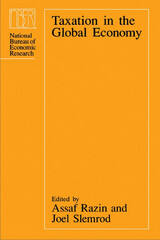 Taxation in the Global Economy
Edited by Assaf Razin and Joel Slemrod
University of Chicago Press, 1990 The increasing globalization of economic activity is bringing an awareness of the international consequences of tax policy. The move toward the common European market in 1992 raises the important question of how inefficiencies in the various tax systems—such as self-defeating tax competition among member nations—will be addressed. As barriers to trade and investment tumble, cross-national differences in tax structures may loom larger and create incentives for relocations of capital and labor; and efficient and equitable income tax systems are becoming more difficult to administer and enforce, particularly because of the growing importance of multinational enterprises. What will be the role of tax policy in this more integrated world economy?
Assaf Razin and Joel Slemrod gathered experts from two traditionally distinct specialties, taxation and international economics, to lay the groundwork for understanding these issues, which will require the attention of scholars and policymakers for years to come.
Contributors describe the basic provisions of the U.S. tax code with respect to international transactions, highlighting the changes contained in the U.S. Tax Reform Act of 1986; explore the ways that tax systems influence the decisions of multinationals; examine the effect of taxation on trade patterns and capital flows; and discuss the implications of the opening world economy for the design of optimal international tax policy. The papers will prove valuable not only to scholars and students, but to government economists and international tax lawyers as well.
 The Taxation of Capital Income
Alan J. Auerbach
Harvard University Press, 1983 This important contribution to tax analysis presents seven related theoretical essays that examine the effects of capital income taxation on the behavior of firms. It is divided into three sections, focusing on optimal tax design, firm financial policy, and inflation. Taken together, the essays demonstrate the powerful role taxes play in shaping the behavior of American corporations, and also provide insights into the difficult task of tax reform.
Alan Auerbach’s results suggest policies the government might adopt to promote the optimal accumulation of capital. He examines the implications for capital taxation of discrepancies between nominal depreciation rates and real economic depreciation, and suggests appropriate rules of thumb for determining when capital taxation is neutral among alternative investment projects. He also makes important contributions to the debate over the integration of corporate and personal taxes on capital income and to the behavioral puzzle of why corporations pay dividends to their shareholders.
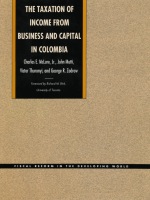 The Taxation of Income from Business and Capital in Colombia
Charles E. McLure, Jr., John Mutti, Victor Thuronyi, and George R. Zodrow
Duke University Press, 1990 “Over the years Colombian tax officials have received the benefit of first-class advice of leading foreign scholars. In return, these scholars—and indeed everyone concerned with development policy—have gained a great deal both from the unusual willingness of Colombians to consider new ideas in detail and then, after full public discussion, drawing on the work of these experts to design a ‘made-in-Colombia’ solution.
“[The book’s] most important contribution, however, is undoubtedly with respect to consumption taxes. No one, anywhere, has thought through with such care just how the so-called ‘simplified alternative tax’ (essentially a direct personal consumption tax combined with a cash-flow corporate tax) might work in the real world. Since such taxes are increasingly being considered—if not adopted—all over the world, in developing and developed countries alike, for this reason alone this book should be high on the reading list of all those concerned with the design and implementation of efficient and equitable direct tax systems.”—From the Foreword by Richard M. Bird
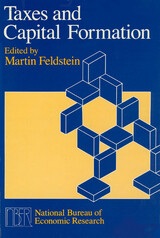 Taxes and Capital Formation
Edited by Martin Feldstein
University of Chicago Press, 1987 Economists have long recognized the importance of capital accumulation for productivity and economic growth. The National Bureau of Economic Research is currently engaged in a study of the relationship between such accumulation and taxation policies, with particular focus on saving, risk-taking, and corporate investment in the United States and abroad. The papers presented in Taxes and Capital Formation are accessible, nontechnical summaries of fourteen individual research projects within that study. Complete technical reports on this research are published in a separate volume, The Effects of Taxation on Capital Accumulation, also edited by Martin Feldstein.
By addressing some of the most critical policy issues of the day with a minimum of economic jargon, Taxes and Capital Formation makes the results of Bureau research available to a wide audience of policy officials and staff as well as to members of the business community. The volume should also prove useful for courses in public policy, business, and law. In keeping with Bureau tradition, the papers do not contain policy recommendations; instead, they promote a better understanding of how the economy works and the effects of specific policies on particular aspects of the economy.
 Taxes and People in Israel
Harold C. Wilkenfeld
Harvard University Press, 1973 "In tax administration," writes the author, "all countries can learn from each other." This revealing case study of the development of Israel's tax system--a system which has dealt with the full panoply of problems that tax administrators must face and which is further characterized by heavy taxation--offers a wealth of noteworthy examples for other countries.
Harold C. Wilkenfeld presents a detailed account of the historical and economic realities that forged Israel's elaborate tax structure from the Ottoman period to the present day. He scrutinizes such areas as the crises that Israel's tax administration faced shortly after the State achieved its independence, the problems which had to be solved, the formulation of administrative policy, the interplay of a developing civil service and a developing citizenry. All of these areas are viewed in the context of an evolving economy and a continuing external conflict.
The author presents practical guidelines for countries interested in advancing the effectiveness of tax administration. For instance, many of the Israeli administration's tactics against tax evasion may be transplantable to other nations. Likewise, a number of the technical solutions to administrative problems of both direct and indirect taxes can certainly and readily be adapted to conditions in a number of developing countries.
Taxes and People in Israel comes as a welcome addition to a field which offers few critical, historical studies of the entire tax system of a country. It will be of considerable interest to tax administrators and ought to be read by every new head of a tax administration. It should also prove a valuable source to public administrators, lawyers, sociologists, economists, and anyone concerned with giving fiscal advice to the developing countries.
 Taxi from Another Planet: Conversations with Drivers about Life in the Universe
Charles S. Cockell
Harvard University Press, 2022 Insightful, good-humored essays on the possibilities of alien life and the uses of space exploration, based on an astrobiologist’s everyday conversations with his fellow humans—taxi drivers, to be precise. “This is a joy to read.” —Publishers Weekly
If you’ve ever sat in the back seat of a taxi, you know that cabbies like to talk. Sports or politics, your job or theirs, taxi drivers are fine conversationalists on just about any topic. And when the passenger is astrobiologist Charles Cockell, that topic is usually space and what, if anything, lives out there.
Inspired by conversations with drivers all over the world, Taxi from Another Planet tackles the questions that everyday people have about the cosmos and our place in it. Will we understand aliens? What if there isn’t life out in the universe? Is Mars our Plan B? And why is the government spending tax dollars on space programs anyway? Each essay in this genial collection takes questions like these as a starting point on the way to a range of insightful, even poignant, observations. Cockell delves into debates over the inevitability of life and looks to both human history and scientific knowledge to consider what first contact will be like and what we can expect from spacefaring societies. He also offers a forceful argument for the sympathies between space exploration and environmentalism.
A shrewd and entertaining foray into the most fundamental mysteries, Taxi from Another Planet brings together the wisdom of scientific experts and their fellow citizens of Earth, the better to understand how life might unfold elsewhere.
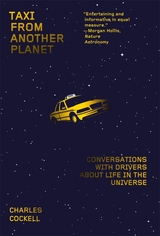 Taxi from Another Planet: Conversations with Drivers about Life in the Universe
Charles S. Cockell
Harvard University Press “Timely…Cockell makes us consider a gamut of new possibilities that boggle the mind.”
—Bruce Dorminey, Forbes
“Taxi from Another Planet conveys an array of ideas—all fascinating, and some profound—with a light touch and utter clarity. Accessible to anyone curious about the cosmos.”—Martin Rees, coauthor of The End of Astronauts
“Entertaining and informative in equal measure.”—Morgan Hollis, Nature Astronomy
If you’ve ever sat in the back seat of a taxi, you know that cabbies like to talk. Sports or politics, your job or theirs, taxi drivers are fine conversationalists on just about any topic. And when the passenger is astrobiologist Charles Cockell, that topic is usually space and what, if anything, lives out there.
Inspired by conversations with drivers all over the world, Taxi from Another Planet tackles the questions that everyday people have about the cosmos and our place in it. Will we understand aliens? What if there isn’t life out in the universe? Is Mars our Plan B? And why is the government spending tax dollars on space programs anyway? Each essay in this genial collection takes questions like these as a starting point on the way to a range of insightful, even poignant, observations. Cockell delves into debates over the inevitability of life and looks to both human history and scientific knowledge to consider what first contact will be like and what we can expect from spacefaring societies. He also offers a forceful argument for the sympathies between space exploration and environmentalism.
A shrewd and entertaining foray into the most fundamental mysteries, Taxi from Another Planet brings together the wisdom of scientific experts and their fellow citizens of Earth, the better to understand how life might unfold elsewhere.
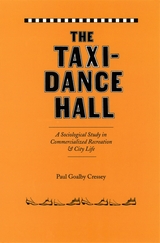 The Taxi-Dance Hall: A Sociological Study in Commercialized Recreation and City Life
Paul Goalby Cressey
University of Chicago Press, 1932 First published in 1932, The Taxi-Dance Hall is Paul Goalby Cressey’s fascinating study of Chicago’s urban nightlife—as seen through the eyes of the patrons, owners, and dancers-for-hire who frequented the city’s notoriously seedy “taxi-dance” halls.
Taxi-dance halls, as the introduction notes, were social centers where men could come and pay to dance with “a bevy of pretty, vivacious, and often mercenary” women. Ten cents per dance was the usual fee, with half the proceeds going to the dancer and the other half to the owner of the taxi-hall. Cressey’s study includes detailed maps of the taxi-dance districts, illuminating interviews with dancers, patrons, and owners, and vivid analyses of local attempts to reform the taxi-dance hall and its attendees.
Cressey’s study reveals these halls to be the distinctive urban consequence of tensions between a young, diverse, and economically independent population at odds with the restrictive regulations of Prohibition America. Thick with sexual vice, ethnic clashes, and powerful undercurrents of class, The Taxi-Dance Hall is a landmark example of Chicago sociology, perfect for scholars and history buffs alike.
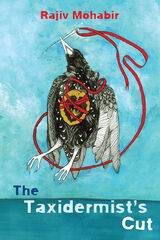 The Taxidermist's Cut
Rajiv Mohabir
Four Way Books, 2016 The Taxidermist’s Cut is a collection that centers the pressures of being a queer brown youth awakening sexually in a racist, anti-immigrant matrix. As an Indo-Caribbean, the queer-countried speaker is illegible as an “Indian” as well as an “American.” Haunted by his migration narrative, the speaker tries to make himself fit into his environment by sloughing off his skin and stretching new ones over his body. At stake here is surviving a palimpsest of violence: violences enacted upon the speaker and violences the speaker enacts upon himself through cutting. Mohabir engages with the body and the land as a series of incisions and overlays to cover the damage of memory of a South Asian brown body dealing with aggressions and joys. This is a collection of twisted love stories-as-slits that exposes the meat and bone of trauma and relief. Drawing from outside source texts such as animal tracking guides and taxidermy manuals, these poems attempt to show the process of how to survive being erased on all fronts.
Taxing Agricultural Land in Developing Countries
Richard M. Bird
Harvard University Press, 1974 Agriculture is the largest economic sector in most countries of Latin American, Africa, and Asia, and the taxation of agricultural land is a potentially important instrument in the development policies of such nations. But there is a large gap between theory and practice, a gap that needs explaining. In addition, there have been interesting changes in thought on the role of such taxation in development. Richard M. Bird covers all this in a complete rethinking of the whole subject. His book is a distinguished successor to Haskell P. Wald’s classic study, Taxation of Agricultural Land in Underdeveloped Economics, published by Harvard University Press in 1959. With abundant evidence Bird argues that the tax system of each country, in order to be effective as a part of development policy, must be tailored carefully to peculiar circumstances and objectives of that country.
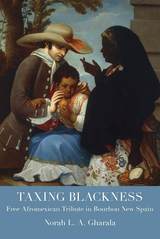 Taxing Blackness: Free Afromexican Tribute in Bourbon New Spain
Norah L. A. Gharala
University of Alabama Press, 2019 A definitive analysis of the most successful tribute system in the Americas as applied to Afromexicans
During the eighteenth century, hundreds of thousands of free descendants of Africans in Mexico faced a highly specific obligation to the Spanish crown, a tax based on their genealogy and status. This royal tribute symbolized imperial loyalties and social hierarchies. As the number of free people of color soared, this tax became a reliable source of revenue for the crown as well as a signal that colonial officials and ordinary people referenced to define and debate the nature of blackness.
Taxing Blackness: Free Afromexican Tribute in Bourbon New Spain examines the experiences of Afromexicans and this tribute to explore the meanings of race, political loyalty, and legal privileges within the Spanish colonial regime. Norah L. A. Gharala focuses on both the mechanisms officials used to define the status of free people of African descent and the responses of free Afromexicans to these categories and strategies. This study spans the eighteenth century and focuses on a single institution to offer readers a closer look at the place of Afromexican individuals in Bourbon New Spain, which was the most profitable and populous colony of the Spanish Atlantic.
As taxable subjects, many Afromexicans were deeply connected to the colonial regime and ongoing debates about how taxpayers should be defined, whether in terms of reputation or physical appearance. Gharala shows the profound ambivalence, and often hostility, that free people of African descent faced as they navigated a regime that simultaneously labeled them sources of tax revenue and dangerous vagabonds. Some free Afromexicans paid tribute to affirm their belonging and community ties. Others contested what they saw as a shameful imposition that could harm their families for generations. The microhistory includes numerous anecdotes from specific cases and people, bringing their history alive, resulting in a wealth of rural and urban, gender, and family insight.
 Taxing Heaven's Storehouse: Horses, Bureaucrats, and the Destruction of the Sichuan Tea Industry, 1074-1224
Paul Jakov Smith
Harvard University Press, 1991 Tea growing was a prosperous industry in Sichuan when Wang Anshi's New Policies created a Tea Market Agency to buy up Sichuanese tea and trade it to Tibetan tribesmen for cavalry horses. At first the highly autonomous Agency not only acquired the needed horses but made a profit. After the Jurchen conquest of North China, however, market realities changed and the combined Tea and Horse Agency's once successful policies ruined tea farmers, failed to meet quotas for horses, and ran a deficit. Smith details the workings of Sichuan tea farming and the tea trade, examines the geopolitical factors that forced the Song to buy horses, and graphically describes the difficulties of driving them more than a thousand miles through rugged mountains with only inexperienced conscripts as trail hands.
In this study of fiscal sociology, Smith also explains how the Tea and Horse Agency transformed the Sichuan local elite, which was notorious for its resistance to state power, into imperial civil servants eager to tax their own region. He draws on modern theories of corporate behavior to explain what made the inner workings of the Agency an extraordinary departure for the Chinese civil service; and he demonstrates how the Agency put into practice the most radical New-Policies theories of state economic activism. The Agency made entrepreneurs out of bureaucrats, but ultimately became ruinously tyrannical as the system of state rewards and punishments drove its personnel to actions that crippled key sectors of the economy.
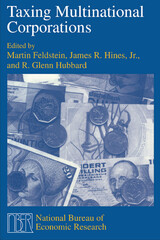 Taxing Multinational Corporations
Edited by Martin Feldstein, James R. Hines Jr., and R. Glenn Hubbard
University of Chicago Press, 1995 In the increasingly global business environment of the 1990s, policymakers and executives of multinational corporations must make informed decisions based on a sound knowledge of U.S. and foreign tax policy. Written for a nontechnical audience, Taxing Multinational Corporations summarizes the up-to-the-minute research on the structure and effects of tax policies collected in The Effects of Taxation on Multinational Corporations. The book covers such practical issues as the impact of tax law on U.S. competitiveness, the volume and location of research and development spending, the extent of foreign direct investment, and the financial practices of multinational companies.
In ten succinct chapters, the book documents the channels through which tax policy in the United States and abroad affects plant and equipment investments, spending on research and development, the cost of debt and equity finance, and dividend repatriations by United States subsidiaries. It also discusses the impact of U.S. firms' outbound foreign investment on domestic and foreign economies. Especially useful to nonspecialists is an appendix that summarizes current United States rules for taxing international income.
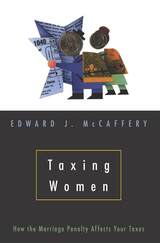 Taxing Women
Edward J. McCaffery
University of Chicago Press, 1997 Taxing Women comprises both an insightful, critical analysis of the gender biases in current tax laws and a wake-up call for all those concerned with gender justice to pay more attention to the pervasive impact of such laws. Providing real-life examples, Edward McCaffery shows how tax laws are actually written to punish married couples who file jointly. No dual-income household can afford not to read this book before filing their taxes.
"Taxing Women is a must-have primer for any woman who wants to understand how our current tax system affects her family's economic condition. In plain English, McCaffery explains how the tax code stacks the deck against women and why it's in women's economic interest to lead the next great tax rebellion."—Patricia Schroeder
"McCaffery is an expert on the interplay between taxes and social policy. . . . Devastating in his analysis. . . . Intriguing."—Harris Collingwood, Working Women
"A wake-up call regarding the inequalities of an archaic system that actually penalizes women for working."—Publishers Weekly
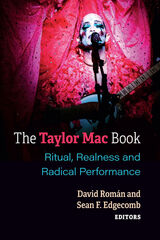 The Taylor Mac Book: Ritual, Realness and Radical Performance
David Román and Sean F. Edgecomb, Editors
University of Michigan Press, 2023 This is the first book to dedicate critical attention to the work of influential theater-maker Taylor Mac. Mac is particularly celebrated for the historic performance event A 24-Decade History of Popular Music, in which Mac, in fantastical costumes designed by collaborator Machine Dazzle, sang the history of the United States for 24 straight hours in October 2016. The MacArthur Foundation soon thereafter awarded their “genius” award to a “writer, director, actor, singer, and performance artist whose fearlessly experimental works dramatize the power of theater as a space for building community . . . [and who] interacts with the audience to inspire a reconsideration of assumptions about gender, identity, ethnicity, and performance itself.”
Featuring essays, interviews, and commentaries by noted critics and artists, the volume examines the vastness of Mac’s theatrical imagination, the singularity of their voice, the inclusiveness of their cultural insights and critiques, and the creativity they display through stylistic and formal qualities and the unorthodoxies of their personal and professional trajectories. Contributors consider the range of Mac’s career as a playwright, performer, actor, and singer, expanding and enriching the conversation on this much-celebrated and deeply resonant body of work.
Taylored Lives: Narrative Productions in the Age of Taylor, Veblen, and Ford
Martha Banta
University of Chicago Press, 1993 Scientific management: technology spawned it, Frederick Winslow Taylor championed it, Thorstein Veblen dissected it, Henry Ford implemented it. By the turn of the century, practical visionaries prided themselves on having arrived at "the one best way" both to increase industrial productivity and to regulate human behavior. Martha Banta takes a close look at texts ranging from mail order catalogs and popular romances to the works of Henry Adams and Nathanael West to trace the effects of the efficiency craze on the full fabric of American culture.
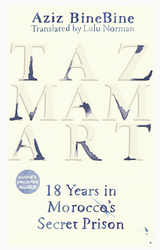 Tazmamart: 18 Years in Morocco's Secret Prison
Aziz BineBine
Haus Publishing, 2021 A memoir from a political prisoner in Morocco's notorious Tazmamart prison.
On July 10, 1971, during birthday celebrations for King Hassan II of Morocco, attendant officers and cadets opened fire on visiting dignitaries. A young officer, Aziz BineBine, arrived late and witnessed the ensuing massacre without firing a single shot, yet he would spend the next two decades in a political prison hidden in the Atlas Mountains—Tazmamart. Conditions in this now-infamous prison were nightmarish. The dark, underground cells, too small for standing up in, exposed prisoners to extreme weather, overflowing sewage, and disease-ridden rats. Forgetting life outside his cell—his past, his family, his friends—and clinging to God, BineBine resolved to survive. Tazmamart: 18 Years in Morocco’s Secret Prison is a memorial to BineBine and his fellow inmates’ sacrifice. This searing tale of endurance offers an unfiltered depiction of the agonizing life of a political prisoner.
The Tbilisi Symposium on Logic, Language and Computation: Selected Papers
Edited by Jonathan Ginzburg, Zurab Khasidashvili, Carl Vogel, Jean-Jacques Lévy,
CSLI, 1998 This volume brings together papers from linguists, logicians, and computer scientists from thirteen countries (Armenia, Denmark, France, Georgia, Germany, Israel, Italy, Japan, Poland, Spain, Sweden, UK, and USA). This collection aims to serve as a catalyst for new interdisciplinary developments in language, logic and computation and to introduce new ideas from the expanded European academic community. Spanning a wide range of disciplines, the papers cover such topics as formal semantics of natural language, dynamic semantics, channel theory, formal syntax of natural language, formal language theory, corpus-based methods in computational linguistics, computational semantics, syntactic and semantic aspects of l-calculus, non-classical logics, and a fundamental problem in predicate logic.
TCJ vol 69 num 1
The University of Chicago Press
University of Chicago Press Journals, 2013
TCJ vol 70 num 1
The University of Chicago Press
University of Chicago Press Journals, 2013
TCJ vol 71 num 1
The University of Chicago Press
University of Chicago Press Journals, 2014
TCJ vol 72 num 1
The University of Chicago Press
University of Chicago Press Journals, 2014
TCJ vol 73 num 1
The University of Chicago Press
University of Chicago Press Journals, 2015
TCJ vol 74 num 1
The University of Chicago Press
University of Chicago Press Journals, 2015
TCJ vol 75 num 1
The University of Chicago Press
University of Chicago Press Journals, 2016
TCJ vol 76 num 1
The University of Chicago Press
University of Chicago Press Journals, 2016
TCJ vol 77 num 1
The University of Chicago Press
University of Chicago Press Journals, 2017
TCJ vol 78 num 1
The University of Chicago Press
University of Chicago Press Journals, 2017
TCJ vol 79 num 1
The University of Chicago Press
University of Chicago Press Journals, 2018
TCJ vol 80 num 1
The University of Chicago Press
University of Chicago Press Journals, 2018
TCJ vol 81 num 1
The University of Chicago Press
University of Chicago Press Journals, 2019
TCJ vol 82 num 1
The University of Chicago Press
University of Chicago Press Journals, 2019
TCJ vol 83 num 1
The University of Chicago Press
University of Chicago Press Journals, 2020
TCJ vol 84 num 1
The University of Chicago Press
University of Chicago Press Journals, 2020
TCJ vol 85 num 1
The University of Chicago Press
University of Chicago Press Journals, 2021
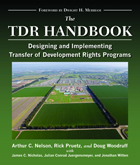 The TDR Handbook: Designing and Implementing Transfer of Development Rights Programs
Arthur C. Nelson, Rick Pruetz, and Doug Woodruff with James C. Nicholas, JulianConrad Juergensmeyer, and Jonathan Witten
Island Press, 2011 "Transfer of Development Rights" (TDR) programs allow local governments to put economic principles to work in encouraging good land use planning. TDR programs most often permit landowners to forfeit development rights in areas targeted for preservation and then sell those development rights to buyers who want to increase the density of development in areas designated as growth areas by local authorities.
Although TDR programs must conform to zoning laws, they provide market incentives that make them more equitable (and often more lucrative) for sellers and frequently benefit buyers by allowing them to receive prior approval for their high-density development plans. Since the 1970s when modern TDR applications were first conceived, more than 200 communities in 33 states across the U.S. have implemented TDR-based programs. The most common uses of TDR to date involve protecting farmland, environmentally sensitive land, historic sites, and "rural character," and urban revitalization.
Until now, however, there has never been a clearly written, one-volume book on the subject. At last, The TDR Handbook provides a comprehensive guide to every aspect of TDR programs, from the thinking behind them to the nuts and bolts of implementation-including statutory guidance, model ordinances, suggestions for program administration, and comparisons with other types of preservation programs. In addition, six of its twenty chapters are devoted to case studies of all major uses to which TDR programs have been utilized to date, including recent urban revitalization projects that utilize TDR principles.
 Tea, Coffee & Chocolate: How We Fell in Love with Caffeine
Melanie King
Bodleian Library Publishing, 2015 There are few things in the world more pleasing than a decadent cup of hot chocolate, a steaming mug of one’s favorite tea, or that first wonderful sip of freshly brewed coffee. Three of the great culinary obsessions of the twenty-first century, tea, coffee, and chocolate are long-time favorites of both casual diners and foodies, But how did we become so enamored of the big three?
In her mouthwatering new book, Melanie King offers a concise cultural history. All three beverages hail from faraway places: tea came first from China, coffee from the Middle East, and chocolate from Central America. Physicians and politicians alike were quick to comment in newspapers and popular periodicals on their supposed perils or health benefits. Readers learn that coffee was recommended in the seventeenth century as protection against the bubonic plague. Tea was thought to make women unattractive and men “unfit to do their business,” while a cup of chocolate was supposed to have exactly the opposite effect on the drinker’s sex life and physical appearance. As consumption of these newly discovered delicacies grew, merchants seized on the opportunity by setting up coffee houses or encouraging ever-more-elaborate tea-drinking rituals.
Filled with fascinating and often funny anecdotes—from a goatherd whose flock became frisky after eating coffee berries to a duchess with a goblet of poisoned chocolate, Tea, Coffee & Chocolate shows how the rowdy initial reception of these drinks forms the roots of today’s enduring caffeine culture.
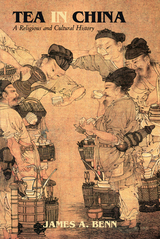 Tea in China: A Religious and Cultural History
James A. Benn
University of Hawaii Press, 2015 Tea in China explores the contours of religious and cultural transformation in traditional China from the point of view of an everyday commodity and popular beverage. The work traces the development of tea drinking from its mythical origins to the nineteenth century and examines the changes in aesthetics, ritual, science, health, and knowledge that tea brought with it. The shift in drinking habits that occurred in late medieval China cannot be understood without an appreciation of the fact that Buddhist monks were responsible for not only changing people’s attitudes toward the intoxicating substance, but also the proliferation of tea drinking. Monks had enjoyed a long association with tea in South China, but it was not until Lu Yu’s compilation of the Chajing (The Classic of Tea) and the spread of tea drinking by itinerant Chan monastics that tea culture became popular throughout the empire and beyond. Tea was important for maintaining long periods of meditation; it also provided inspiration for poets and profoundly affected the ways in which ideas were exchanged. Prior to the eighth century, the aristocratic drinking party had excluded monks from participating in elite culture. Over cups of tea, however, monks and literati could meet on equal footing and share in the same aesthetic values. Monks and scholars thus found common ground in the popular stimulant—one with few side effects that was easily obtainable and provided inspiration and energy for composing poetry and meditating. In addition, rituals associated with tea drinking were developed in Chan monasteries, aiding in the transformation of China’s sacred landscape at the popular and elite level. Pilgrimages to monasteries that grew their own tea were essential in the spread of tea culture, and some monasteries owned vast tea plantations. By the end of the ninth century, tea was a vital component in the Chinese economy and in everyday life. Tea in China transcends the boundaries of religious studies and cultural history as it draws on a broad range of materials—poetry, histories, liturgical texts, monastic regulations—many translated or analyzed for the first time. The book will be of interest to scholars of East Asia and all those concerned with the religious dimensions of commodity culture in the premodern world.
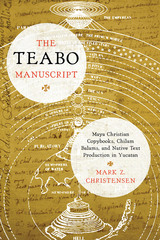 The Teabo Manuscript: Maya Christian Copybooks, Chilam Balams, and Native Text Production in Yucatán
By Mark Z. Christensen
University of Texas Press, 2016 Winner, LASA Mexico Humanities Book Prize, 2017 Among the surviving documents from the colonial period in Mexico are rare Maya-authored manuscript compilations of Christian texts, translated and adapted into the Maya language and worldview, which were used to evangelize the local population. The Morely Manuscript is well known to scholars, and now The Teabo Manuscript introduces an additional example of what Mark Z. Christensen terms a Maya Christian copybook. Recently discovered in the archives of Brigham Young University, the Teabo Manuscript represents a Yucatecan Maya recounting of various aspects of Christian doctrine, including the creation of the world, the Fall of Adam and Eve, and the genealogy of Christ. The Teabo Manuscript presents the first English translation and analysis of this late colonial Maya-language document, a facsimile and transcription of which are also included in the book. Working through the manuscript section by section, Christensen makes a strong case for its native authorship, as well as its connections with other European and Maya religious texts, including the Morely Manuscript and the Books of Chilam Balam. He uses the Teabo Manuscript as a platform to explore various topics, such as the evangelization of the Maya, their literary compositions, and the aspects of Christianity that they deemed important enough to write about and preserve. This pioneering research offers important new insights into how the Maya negotiated their precontact intellectual traditions within a Spanish and Catholic colonial world.
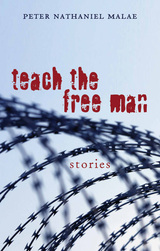 Teach the Free Man: Stories
Peter Nathaniel Malae
Ohio University Press, 2007 The twelve stories in Teach the Free Man mark the impressive debut of Peter Nathaniel Malae. The subject of incarceration thematically links the stories, yet their range extends beyond the prison’s barbed wire and iron bars. Avoiding sensationalism, Malae exposes the heart and soul in those dark, seemingly inaccessible corridors of the human experience. The stories, often raw and startlingly honest, are distinguished by the colloquial voices of California’s prison inmates, who, despite their physical and cultural isolation, confront dilemmas with which we can all identify: the choice to show courage against peer pressure; the search for individual rights within a bureaucracy; and the desperate desire for honor in the face of great sacrifice. These stories present polished and poetic examples of finding something redemptive in the least among us. The book’s epigraph by W. H. Auden, from which the book takes its title, exemplifies the spirit of these dynamic stories:
In the deserts of the heart
Let the healing fountain start.
In the prison of his days
Teach the free man how to praise.
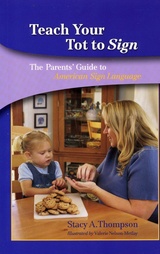 Teach Your Tot to Sign: The Parents' Guide to American Sign Language
Stacy A. Thompson
Gallaudet University Press, 2005 Research has shown that very young children can learn sign language before they learn to speak. Teach Your Tot to Sign: The Parents’ Guide to American Sign Language provides parents and teachers the opportunity to teach more than 500 basic American Sign Language (ASL) signs to their infants, toddlers, and young children. Hearing children, deaf children, and children with special needs can benefit from learning the elementary signs chosen for this handy pocket-size book. Young children who can communicate using simple signs become less frustrated and also bond in a special way with their parents. In teaching ASL to parents of toddlers and preschool teachers, author Stacy A. Thompson recognized the need for a book that could be used at home and in the classroom. Her book features fundamental signs of great appeal to young children and concise instructions on how to sign, including the critical importance of facial expression.
Teach Your Tot to Sign anticipates all of the common desires and interests of young children — food, pets, planes, trains, cars, and boats, games, holidays, vegetables, family — in short, nearly everything. Reflecting children’s endless curiosity, the vocabulary chosen ranges from signs for “baby,” “broken,” “clown,” “dinosaur,” “firefighter,” “gentle,” “hot,” “hurt,” “ketchup,” “pacifier,” “rooster,” “sad,” “spaghetti,” “wagon,” “water,” “wet,” to “you’re welcome,” and even “McDonalds.” This lively assortment of signs will help every child convey earlier in their development their thoughts, feelings, and desires to their parents and teachers.
Teacher Education across Minority-Serving Institutions: Programs, Policies, and Social Justice
Petchauer, Emery
Rutgers University Press, 2017 Winner of the 2018 AERA Division K Exemplary Research in Teaching and Teacher Education Award
The first of its kind, Teacher Education across Minority-Serving Institutions brings together innovative work from the family of institutions known as minority-serving institutions: Historically Black Colleges and Universities, Tribal Colleges and Universities, Hispanic Serving Institutions, and Asian American and Native American Pacific Islander Serving Institutions. The book moves beyond a singular focus on teacher racial diversity that has characterized scholarship and policy work in this area. Instead, it pushes for scholars to consider that racial diversity in teacher education is not simply an end in itself but is, a means to accomplish other goals, such as developing justice-oriented and asset-based pedagogies.
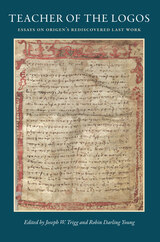 Teacher of the Logos: Essays on Origen's Rediscovered Last Work
Joseph W. Trigg
Catholic University of America Press In 2012 Marina Molin Pradel, an archivist at the Bavarian State Library discovered that CMG 314, a long-neglected Byzantine manuscript , contained twenty-nine homilies by Origen, the most important and most talented genius of early Christianity. He delivered these homilies around 259 CE, shortly before arrest and torture during the Decian persecution would put an end to his work. Thus, along with the Contra Celsum, Origen’s lengthy defense of Christianity, written after 248, when that persecution was clearly impending, they enable readers to appreciate Origen’s fully-developed thought.
Except for the four of these homilies that had been translated into Latin in the fifth century, scholars of Origen thought that all the homilies on the Psalms had been lost. In 2015 Lorenzo Perrone of the University of Bologna, an eminent Origen scholar, assisted by a team including Dr. Pradel, produced a magnificent critical edition of the text.
In 2017 the editors of this volume organized a colloquium in Washington, DC, generously hosted by the program in Early Christian Studies. The authors of this volume, a group of American and Canadian scholars, invited Professor Perrone to address the discovery of the homilies and his edition, and to join their discussion of their interpretation. This volume represents the group’s energetic investigations and discussion over the two days of the conference. The essays address Origen’s use of language, his philosophical interests, his relationship with Judaism, and his scholarly patrimony in the next century.
 Teacher Research and Educational Reform
Edited by Sandra Hollingsworth and Hugh Sockett
University of Chicago Press, 1994 Since the late 1950s, two ideas have dominated the debate surrounding the role of teacher research in the process of educational reform. Supporters of a "control paradigm" believe that teachers should be subordinate to university researchers in the formulation of new educational techniques. Opposing them are members of the "teacher autonomy" movement who favor decentralizing the reform process and making teachers the primary source of new ideas. By challenging the assumptions of conventional reform efforts, this volume applies fresh thinking to an old problem.
Three critiques form this postmodern approach to teacher research. An epistemological critique considers issues of power in the relationship of university researchers to teachers. A sociopolitical critique examines the relationships that a teacher may have to the research process. A professional critique argues for staff development programs that encourage teachers to take greater responsibility for curriculum and instruction and for institutional structures that support teacher research as a professional activity.
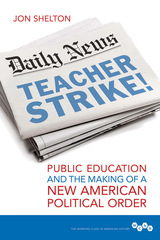 Teacher Strike!: Public Education and the Making of a New American Political Order
Jon Shelton
University of Illinois Press, 2017 A wave of teacher strikes in the 1960s and 1970s roiled urban communities. Jon Shelton illuminates how this tumultuous era helped shatter the liberal-labor coalition and opened the door to the neoliberal challenge at the heart of urban education today. As Shelton shows, many working- and middle-class whites sided with corporate interests in seeing themselves as society's only legitimate, productive members. This alliance increasingly argued that public employees and the urban poor took but did not give. Drawing on a wealth of research ranging from school board meetings to TV news reports, Shelton puts readers in the middle of fraught, intense strikes in Newark, St. Louis, and three other cities where these debates and shifting attitudes played out. He also demonstrates how the labor actions contributed to the growing public perception of unions as irrelevant or even detrimental to American prosperity. Foes of the labor movement, meanwhile, tapped into cultural and economic fears to undermine not just teacher unionism but the whole of liberalism.
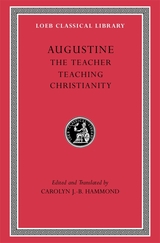 The Teacher. Teaching Christianity
Augustine
Harvard University Press, 2025 Magisterial pedagogy.
Aurelius Augustine (AD 354–430), one of the most important figures in the development of western Christianity and philosophy, was the son of a pagan, Patricius of Tagaste, and his Christian wife, Monnica. While studying to become a rhetorician, he plunged into a turmoil of philosophical and psychological doubts, leading him to Manichaeism. In 383 he moved to Rome and then Milan to teach rhetoric. Despite exploring classical philosophical systems, especially skepticism and Neoplatonism, his studies of Paul’s letters with his friend Alypius, and the preaching of Bishop Ambrose, led in 386 to his momentous conversion from mixed beliefs to Christianity. He soon returned to Tagaste and founded a religious community, and in 395 or 396 became Bishop of Hippo.
The Teacher (De Magistro) dates from the beginning of Augustine’s scholarly career, and Teaching Christianity (De Doctrina Christiana) from its end. Together with Confessions, these treatises contain various remembrances and reflections drawn from Augustine’s personal educational experiences over time, allowing the reader to trace the development of his mature understanding of what teaching is, or should be. They also showcase his prowess as a theorist and thinker of timeless importance.
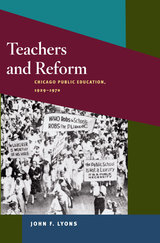 Teachers and Reform: Chicago Public Education, 1929-70
John F. Lyons
University of Illinois Press, 2007 From the union's formation in 1937 until the 1960s, the Chicago Teachers Union (CTU) was the largest and most influential teachers' union in the country. John F. Lyons examines the role of public schoolteachers and the CTU in shaping the policies and practices of public education in Chicago. Examining teachers' unions and public education from the bottom up, Lyons shows how the CTU and its members sought rigorous reforms. A combination of political action, public relations campaigns, and community alliances helped the CTU to achieve better salaries and benefits, increased school budgets, reformed curricula, and greater equality for women within the public education system. But its agenda was also constrained by internal divisions over race and gender and by ongoing external disputes with the school administration, politicians, and business and civic organizations. Detailed and informed by rich interviews, Teachers and Reform: Chicago Public Education, 1929-1970 tells the story of how committed union members effected changes to public education and to local politics that still benefit Chicago teachers, students, and the city today.
 Teachers and Teaching on Stage and on Screen: Dramatic Depictions
Edited by Diane Conrad and Monica Prendergast
Intellect Books, 2019 Why are educators and their profession the focus of so much film and theater? In this volume, Diane Conrad and Monica Prendergast bring together scholars and practitioners in education to answer this very question. Films such as Freedom Writers, Bad Teacher, and School of Rock, to name a few, intentionally or inadvertently comment on education and influence the opinions and, ultimately, the experiences of anyone who has taught or been taught. The essays compiled in this collection critique the Hollywood “good teacher” repertoire, delve into satiric parodies and alternative representations, and explore issues through analyses of independent and popular films and plays from around the world. By examining teacher–student relationships, institutional cultures, societal influences, and much more, Teachers and Teaching on Stage and on Screen addresses these media’s varied fascinations with the educator like no collection has before.
Teachers and Testing
David A. Goslin
Russell Sage Foundation, 1967 Discusses the uses and abuses of intelligence testing in our educational systems. Dr. Goslin examines teachers' opinions and practices with regard to tests and finds considerable discrepancies between attitude and behavior. He points to the need for formulation of school policies that clearly specify what role teachers are to play in the measurement process. Dr. Goslin makes several policy recommendations, stressing the idea that the measuring process must take into account many aspects of a child's background and characteristics, and must guard against premature labeling or over-categorization.
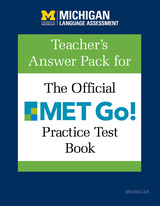 Teacher's Answer Pack for The Official MET Go! Practice Test Book
Michigan Language Assessment
University of Michigan Press, 2019 The MET Go! is a standardized international examination designed by Michigan Language Assessment and aimed at beginner- to intermediate-level adolescent language learners—A1 to B1 of the Common European Framework of Reference for Languages (CEFR). The test assesses general English language proficiency in educational, social, and everyday contexts and emphasizes the ability of the test-taker to communicate effectively in English. The MET Go! is intended for early adolescents at the middle school to lower-secondary school level who want to measure their general English language proficiency in a variety of linguistic contexts. The test results can be used for educational purposes, such as when finishing an English language course, as a motivational tool to encourage students as they progress in their English study, or as a supporting credential for youth opportunities requiring English skills. It may also be used as a bridge to a higher-level exam such as the MET. The Teacher’s Answer Pack for The Official MET Go! Practice Test Book includes: - answer keys
- audio transcripts for the Listening practice tests
- Writing test responses with commentary for two of the practice tests
- examiner instructions and script for the Speaking test prompts
- selected practice test vocabulary lists
- a progress tracking log for recording practice test scores
- actual test form instructions and a sample answer sheet
The audio for the Listening practice tests can be accessed at www.press.umich.edu/elt/compsite/metgo.
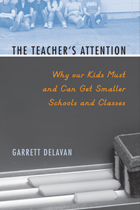 The Teacher's Attention: Why Our Kids Must and Can Get Smaller Schools and Classes
Garrett Delavan
Temple University Press, 2009 The Teacher’s Attention is a fresh take on relationships in schools. Looking beyond our obsession with raising test scores, this book recognizes that education is a key partner in raising children. Garrett Delavan contends that allowing students, educators and parents to navigate a smaller number of relationships—a concept he calls "relationship load"—provides many benefits, including a better chance at achieving equal access to a good education for all children. Delavan shows how class size, school size, and longer-term student-teacher relationships are all equally critical components for educating our children ethically and successfully. After examining these proposed reforms in detail, Delavan also considers counterarguments and provides a detailed projection of costs and savings, putting to rest the assumption that smaller classes and smaller schools are necessarily more expensive. Finally, the book discusses possible steps toward implementation, showing how the author's proposed reforms are remarkably practical.
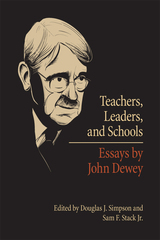 Teachers, Leaders, and Schools: Essays by John Dewey
Edited by Douglas J. Simpson and Sam F. Stack Jr.
Southern Illinois University Press, 2010 John Dewey was one of the most prominent philosophers and educational thinkers of the twentieth century, and his influence on modern education continues today. In Teachers, Leaders, and Schools: Essays by John Dewey, educators Douglas J. Simpson and Sam F. Stack Jr. have gathered some of Dewey’s most user-friendly and insightful essays concerning education with the purpose of aiding potential and practicing teachers, administrators, and policy makers to prepare students for participation in democratic society. Selected largely, but not exclusively, for their accessibility, relevance, and breadth of information, these articles are grouped into five parts—The Classroom Teacher, The School Curriculum, The Educational Leader, The Ideal School, and The Democratic Society. Each part includes an introductory essay that connects Dewey’s thoughts not only to each other but also to current educational concerns. The sections build on one another, revealing Dewey’s educational theories and interests and illustrating how his thoughts remain relevant today.
Teacher's Manual for Elementary Latin: The Basic Structures
by Grace A. Crawford and Clara W. Ashley, Jane M. Infield, Frederick F. Kempner
University of Michigan Press, 1965 The Teacher's Manual for Elementary Latin offers additional background information, “Lectiones” and other additional readings, Picture Paragraphs, and Picture Questions, for further use by students and the teacher.
Teachers of History in the Universities of the United Kingdom and the Republic of Ireland 2017
Compiled by Lauren De'Ath and Emily Morrell
University of London Press, 2017 Lists over 3,000 people teaching history in United Kingdom and Irish universities and colleges of higher education Gives full degrees and honours for each teacher, with the teaching position held Describes each individual’s teaching area and research interests Supplies the address, telephone and fax number of all departments of history Includes email addresses for the majority of individuals Gives website addresses for all universities with history departments The online version of Teachers of History, available on the IHR website, can be searched to discover all teachers engaged in particular types of history, geographical area and period, or any combination of these.
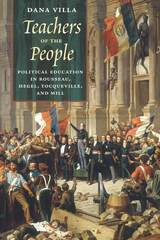 Teachers of the People: Political Education in Rousseau, Hegel, Tocqueville, and Mill
Dana Villa
University of Chicago Press, 2017 2016 witnessed an unprecedented shock to political elites in both Europe and America. Populism was on the march, fueled by a substantial ignorance of, or contempt for, the norms, practices, and institutions of liberal democracy. It is not surprising that observers on the left and right have called for renewed efforts at civic education. For liberal democracy to survive, they argue, a form of political education aimed at “the people” is clearly imperative.
In Teachers of the People, Dana Villa takes us back to the moment in history when “the people” first appeared on the stage of modern European politics. That moment—the era just before and after the French Revolution—led many major thinkers to celebrate the dawning of a new epoch. Yet these same thinkers also worried intensely about the people’s seemingly evident lack of political knowledge, experience, and judgment. Focusing on Rousseau, Hegel, Tocqueville, and Mill, Villa shows how reformist and progressive sentiments were often undercut by skepticism concerning the political capacity of ordinary people. They therefore felt that “the people” needed to be restrained, educated, and guided—by laws and institutions and a skilled political elite. The result, Villa argues, was less the taming of democracy’s wilder impulses than a pervasive paternalism culminating in new forms of the tutorial state.
Ironically, it is the reliance upon the distinction between “teachers” and “taught” in the work of these theorists which generates civic passivity and ignorance. And this, in turn, creates conditions favorable to the emergence of an undemocratic and illiberal populism.
Teachers on the Waves of Transformation: School Culture Before and After 1989
Dana Moree
Karolinum Press, 2020 It is known that a society in transformation undergoes significant changes on many levels, but structural and cultural changes are arguably two of the most significant. How do such monumental changes affect the lives of individuals and small communities?
Teachers on the Waves of Transformation aims to answer this question through the lens of education. With careful exploratory research at two schools in a small town in central Bohemia, anthropologist Dana Moree follows the fates of two generations of teachers at the schools. Through interviews with teachers, school administrators, and the students’ parents, Moree focuses on the relationships, values, shared stories, and symbolic and ritual worlds that create the culture of the schools. Teachers on the Waves of Transformation offers a unique perspective of cultural flux as witnessed in the classroom.
Teaching About Place: Learning From The Land
Laird Christensen
University of Nevada Press, 2008 The sixteen essays in this anthology describe the practice of teaching about place, with the goal of inspiring educators as well as other readers to discover the value of close investigation of their own places. The contributors discuss places from the desert river canyons of the American West, to the bayous of Texas, to wildlife refuges on the Atlantic Coast, to New England’s forests and river, and back to the wildland-urban interface in suburban Southern California. These essays reveal broader lessons about the possibilities and limitations that come with teaching about place and inhabiting our own places outside the classroom. Contributors include: Ann Zwinger, Bradley John Monsma, SueEllen Campbell, Terrell Dixon, and John Elder.
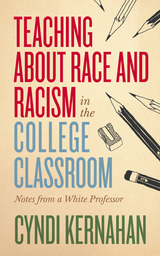 Teaching about Race and Racism in the College Classroom: Notes from a White Professor
Cyndi Kernahan
West Virginia University Press, 2019 Teaching about race and racism can be a difficult business. Students and instructors alike often struggle with strong emotions, and many people have robust preexisting beliefs about race. At the same time, this is a moment that demands a clear understanding of racism. It is important for students to learn how we got here and how racism is more than just individual acts of meanness. Students also need to understand that colorblindness is not an effective anti-racism strategy. In this book, Cyndi Kernahan argues that you can be honest and unflinching in your teaching about racism while also providing a compassionate learning environment that allows for mistakes and avoids shaming students. She provides evidence for how learning works with respect to race and racism along with practical teaching strategies rooted in that evidence to help instructors feel more confident. She also differentiates between how white students and students of color are likely to experience the classroom, helping instructors provide a more effective learning experience for all students.
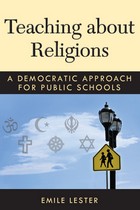 Teaching about Religions: A Democratic Approach for Public Schools
Emile Lester
University of Michigan Press, 2013 "This provocative and timely book challenges Americans to rethink what it means to take democracy and religious freedom seriously in public education. Emile Lester takes the reader beyond culture war conflicts rooted in religious divisions and offers bold, new solutions for addressing our differences with fairness and robust toleration. Instead of battlegrounds, he argues, public schools can and should be places that include all voices in ways that prepare citizens to engage one another with civility and respect. Teaching about Religions is essential reading for all who care about the future of public schools---and the health of American democracy."
--- Charles C. Haynes, Senior Scholar, Freedom Forum First Amendment Center "More than simply a synthesis of existing scholarship, [this book is] an original contribution to the field. [The] major themes are timely, and this book might well contribute to public discussion of important issues in our culture wars."
---Warren Nord, University of North Carolina–Chapel Hill "Arriving in the wake of a bitter battle over the place of Islam in America and in the midst of calls for greater understanding and civility, Emile Lester's new book is a timely contribution to the debate about the best ways to teach about religion in our nation's public schools. A pioneering researcher in this field, Lester offers thoughtful critiques of existing proposals as well as fresh ideas. His recommendations reflect painstaking efforts to understand the concerns of groups (most notably, conservative Christians) to which he does not belong, and a firm grasp of the difference between fostering understanding of other faiths and pressing for acceptance of them. Lester's prescriptions, always informed and fair-minded and sometimes provocative, should drive the debate forward in productive ways."
---Melissa Rogers, Director, Center for Religion and Public Affairs at Wake Forest University School of Divinity and Nonresident Senior Fellow, The Brookings Institution Frequent news stories about the debates waged between secularists and religious conservatives have convinced most Americans that public schools must choose between promoting respect for religious minorities and respecting the interests of conservative Christians. As a result, public schools fail to teach students about the meaning and value of protecting religious liberty and consequently perpetuate mistrust across the cultural divide, further empower extremists, and obscure the fact that most Americans of all religious backgrounds share a commitment to basic democratic principles. In response, the public schools in the religiously diverse and divided community of Modesto, California, have introduced a widely acclaimed required world religions course. Drawing on groundbreaking research on the creation of and response to the Modesto course as well as on political philosophy, Emile Lester advocates a civic approach to teaching about religion in public schools that at once emphasizes respect for all views about religion and provides a special recognition of conservative Christian beliefs.
 Teaching Academic Writing in the Health Sciences: A Guide for Instructors, Mentors, and Trainers
Ella August
University of Michigan Press, 2026 Immersing trainees into academic research culture helps them learn to think, write, and publish like full-fledged researchers. Teaching Academic Writing in the Health Sciences offers best practice pedagogical strategies to help instructors, mentors, advisors, lab leaders, and ministries of health as they guide trainees toward professional development and publication. With practical strategies and examples, the book supports readers in improving their mentoring skills; creating effective writing assignments; providing effective feedback; developing writing courses; and planning publication workshops, retreats, and writing groups. In addition, the book includes strategies for supporting writers with varying backgrounds, including second-language speakers and neurodiverse writers. Part 1 offers the pedagogical basis teachers need to apply best practices, as well as: - Tips for collaborative writing and writing productivity
- Strategies for using generative artificial intelligence (AI) technology in teaching and writing
- Open-access resources and instruction planning activities
Part 2 focuses on the steps of writing a scientific paper, offering: - A strong foundation in the structure of and strategies for successful writing
- Customizable teaching materials on how to write a scientific paper
- Strategies for planning a paper, crafting writing to reach readers, developing persuasive arguments, and building a successful author team
- How-to write each section of a paper, from the title to the conclusion
- Guidance on navigating the publishing process, including selecting the appropriate journal and effectively responding to peer-reviewer comments
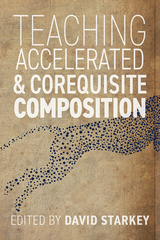 Teaching Accelerated and Corequisite Composition
David Starkey
Utah State University Press, 2023 Teaching Accelerated and Corequisite Composition is the first book to compile on-the-ground advice and teaching strategies specifically curated for accelerated and corequisite writing courses. Trailblazers in the field from colleges across the United States—who developed a foundation for corequisites by facilitating equity and accessibility for marginalized students—speak to a range of topics and demographics, offering support for instructors and practical advice for improving student success.
The book primarily explores accelerated composition through the lens of two-year colleges to answer a central question in the field: to what extent do educators need to alter two-year college curricular design? The contributors also delve into assessment, a crucial process for instructors and their students transitioning to accelerated learning; the key role that reading plays in the writing process; and noncognitive learning, an area of study that has been associated with accelerated learning since its inception. Together these thirteen chapters provide instructors with a strategic approach to teaching accelerated and corequisite composition.
Teaching Accelerated and Corequisite Composition points toward a new way of approaching first-year composition: a method of instruction that fosters the growth and success of writers who were once considered underprepared for college writing and are now achieving unprecedented success.
Teaching Actors: Knowledge Transfer in Actor Training
Ross W. Prior
Intellect Books, 2012 Teaching Actors draws on history, literature, and original research conducted across leading drama schools in England and Australia, to offer those involved in actor training a critical framework within which to think about their work. Prior, who brings to this volume more than twenty years of experience as both a teacher and performer in the field, devotes particular attention to the different ways in which teachers and students acquire and share knowledge through practical craft-based experience. The first book-length treatment of how actor trainers work—and understand their work—Teaching Actors will be an invaluable educational resource in an increasingly important area of theater training and research.
 Teaching Advanced Language Skills through Global Debate: Theory and Practice
Tony Brown and Jennifer Bown
Georgetown University Press, 2016 Using debate to develop advanced competency in a second language is a method that is finding increased interest among instructors and students alike, whether in synchronous online teaching or the individual classroom. Through debate, students learn how to make hypotheses, support their conclusions with evidence, and deploy the rhetoric of persuasion in the target language. Though this method provides an exciting pedagogy for moving students from the advanced to the superior level, there is a paucity of materials available for instructors who wish to plan a curriculum focused on debate. Teaching Advanced Language Skills through Global Debate: Theory and Practice provides teachers with both the theoretical underpinnings for using debate in the foreign language classroom as well as practical advice for developing reading, listening, writing, and speaking skills through debate. It discusses task-based language learning and helps instructors design debate-related tasks for the classroom. Teaching Advanced Language Skills through Global Debate will be useful for any instructor working at the advanced level, and particularly for those training future language instructors. One of the new digital short publications available through Georgetown University Press, it is an ideal complement to the press’s new titles on mastering languages through global debate. Georgetown Digital Shorts—longer than an article, shorter than a book—deliver timely works of peer-reviewed scholarship in a fast-paced, agile environment. They present new ideas and original texts that are easily and widely available to students, scholars, libraries, and general readers.
Teaching against Violence: The Reassessing Toolbox
Inez Testoni
Central European University Press, 2014 Teaching Against Violence deals with gender based violence, paying particular attention to domestic violence, as in this field feminism has tenaciously sought to change the condition of women and, as a result, many international policies have promoted a significant social transformation. The chapters present active techniques that were adopted during the interventions to promote women's empowerment. The contributions face these issues from various perspectives, present the state of the art research in multiple fields of study and suggest educational best practices that can be used where this problem is particularly severe.
 Teaching American Students: A Guide for International Faculty and Teaching Assistants in Colleges and Universities, Third Edition
Ellen Sarkisian
Harvard University Press, 2006 Many faculty and graduate students from other countries expect language difficulties when they teach, but are unprepared for other surprises: different cultures make different assumptions about the academic background of college students, how students learn, the appropriate roles of teachers and students, and even the fundamental purpose of a college education.
The third edition of Teaching American Students explains the expectations of undergraduates at American colleges and universities and offers practical strategies for teaching, including how to give clear presentations, how to teach interactively, and how to communicate effectively. Also included are illustrative examples as well as advice from international faculty and teaching assistants. Appendices offer concrete suggestions on topics from planning the first day of class to grading papers and problem sets.
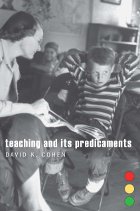 Teaching and Its Predicaments
David K. Cohen
Harvard University Press, 2011 Ever since Socrates, teaching has been a difficult and even dangerous profession. Why is good teaching such hard work?
In this provocative, witty, and sometimes rueful book, David K. Cohen writes about the predicaments that teachers face. Like therapists, social workers, and pastors, teachers embark on a mission of human improvement. They aim to deepen knowledge, broaden understanding, sharpen skills, and change behavior. One predicament is that no matter how great their expertise, teachers depend on the cooperation and intelligence of their students, yet there is much that students do not know. To teach responsibly, teachers must cultivate a kind of mental double vision: distancing themselves from their own knowledge to understand students’ thinking, yet using their knowledge to guide their teaching. Another predicament is that although attention to students’ thinking improves the chances of learning, it also increases the uncertainty and complexity of the job.
The circumstances in which teachers and students work make a difference. Teachers and students are better able to manage these predicaments if they have resources—common curricula, intelligent assessments, and teacher education tied to both—that support responsible teaching. Yet for most of U.S. history those resources have been in short supply, and many current accountability policies are little help. With a keen eye for the moment-to-moment challenges, Cohen explores what “responsible teaching” can be, the kind of mind reading it seems to demand, and the complex social resources it requires.
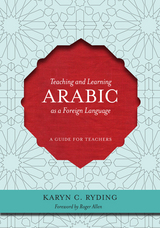 Teaching and Learning Arabic as a Foreign Language: A Guide for Teachers
Karin C. Ryding. Foreword by Roger Allen
Georgetown University Press, 2013 This guide clearly and succinctly presents the basic tenets of teaching foreign languages specifically for Arabic teachers. Consolidating findings from second language acquisition (SLA) research and applied linguistics, it covers designing curricula, theory and methods, goals, testing, and research, and intersperses practical information with background literature in order to help teachers improve their teaching of Arabic as a foreign language (TAFL). Karin C. Ryding, a well-regarded scholar of Arabic linguistics and former president of the American Association of Teachers of Arabic, frames the discussion with SLA literature and suggests practical and effective ways of helping students learn. Ryding discusses issues at the core of Arabic teaching effectiveness and the achievement of communicative competence, such as the teaching of pronunciation, speaking, reading, listening, and writing; teaching mixed-level classes; creative classroom organization; corrective feedback; and use of activities and exercises, with plenty of examples from Arabic and tips for teachers. She also covers materials development and proficiency testing, providing study questions and recommended readings for each chapter. This guide, which can be used as a textbook, is the first of its kind aimed specifically at TAFL, and should be of interest to Arabic instructors-in-training, academics, graduate students, linguists, department chairs, language coordinators, and teacher trainers. It also serves as a resource for teachers of other less commonly taught languages (LCTLs), who struggle with similar issues.
 Teaching and Learning Design: Re:Research, Volume 1
Edited by Gjoko Muratovski and Craig Vogel
Intellect Books, 2020 Just as the term design has been going through change, growth and expansion of meaning, and interpretation in practice and education – the same can be said for design research. The traditional boundaries of design are dissolving and connections are being established with other fields at an exponential rate. Based on the proceedings from the 2017 International Association of Societies of Design Research conference, Re:Research is an edited collection that showcases a curated selection of 83 papers – just over half of the works presented at the conference. With topics ranging from the introduction of design in the primary education sector to designing information for Artificial Intelligence systems, this book collection demonstrates the diverse perspectives of design and design research. Divided into seven thematic volumes, this collection maps out where the field of design research is now.
Opening a Design Education Pipeline from University to K-12 and Back
• Peter Scupelli, Doris Wells-Papanek, Judy Brooks, Arnold Wasserman
To prepare students to imagine desirable futures amidst current planetary-level challenges, design educators must think and act in new ways. In this paper, we describe a pilot study that illustrates how educators might teach K-12 students and university design students to situate their making within transitional times in a volatile and exponentially changing world. We describe how to best situate students to align design thinking and learning with future foresight. Here we present a pilot test and evaluate how a university-level Design Futures course content, approach, and scaffolded instructional materials – can be adapted for use in K-12 Design Learning Challenges. We describe the K-12 design-based learning challenges/experiences developed and implemented by the Design Learning Network (DLN). The Design Futures course we describe in this paper is a required course for third-year undergraduate students in the School of Design at Carnegie Mellon University. The “x” signifies a different type of design that aligns short-term action with long-term goals. The course integrates design thinking and learning with long-horizon future scenario foresight. Broadly speaking, we ask how might portions of a design course be taught and experienced by teachers and students of two different demographics: within the university (Design Undergraduates) and in K-12 (via DLN). This pilot study is descriptive in nature; in future work, we seek to assess learning outcomes across university and K-12 courses. We believe the approach described is relevant for lifelong learners (e.g., post-graduate-level, career development, transitional adult education).
Re-Clarifying Design Problems Through Questions for Secondary School Children: An Example Based on Design Problem Identification in Singapore Pre-Tertiary Design Education
• Wei Leong, Leon Loh, Hwee Mui, Grace Kwek, Wei Leong Lee
It is believed that secondary school students often define design problems in the design coursework superficially due to various reasons such as lack of exposure, inexperience and the lack of research skills. Questioning techniques have long been associated with the development of critical thinking. Based on this context and assumption, the current study aimed to explore the use of questioning techniques to enable pre-tertiary students to improve their understanding of design problems by using questions to critique their thinking and decision-making processes and in turn, generate more effective design solutions. A qualitative approach is adopted in this study to identify the trajectories of students during design problem identification and clarification process. Using student design journals as a form of record for action and thoughts, they are analyzed and supplemented by hearing survey with the teacher-in-charge. From the study, the following points can be concluded: (1) questions can be a useful tool to facilitate a better understanding of the design problem. (2) The process of identification and clarification of design problem is important in the development of critical thinking skills and social-emotional skills of the students. (3) It is important that students are given time and opportunity to find out the problems by themselves. (4) Teachers can be important role models as students may pick up questioning techniques from teacher–student discussions. (5) Departmental reviews and built-in professional development time for weekly reviews on teaching and learning strategies are necessary for the continual improvement D&T education.
Surveying Stakeholders: Research Informing Design Curriculum
• Andrea Quam
Fundamental to design education is the creation and structure of curriculum. Neither the creation of design curriculum, nor the revaluation of existing curriculum is well documented. With no clear documentation of precedent, best practices are left open to debate. This paper and presentation will discuss the use of a survey as a research tool to assess existing curriculum at Iowa State University in the United States. This tool allowed the needs and perspectives of the program’s diverse stakeholders to be better understood. Utilizing survey methods, research revealed the convergence and divergence of stakeholders’ philosophies, theories and needs in relation to design curriculum. Accreditation and professional licensing provide base level of guidelines for design curriculum in the United States. However, each program’s curricular structure beyond these guidelines is a complicated balance of resources, facilities, faculty and the type of institution in which it is housed. Once established, a program’s curriculum is rarely reassessed as a whole, but instead updated with the hasty addition of classes upon an existing curricular structure. Curriculum is infrequently re-addressed, and when it is, it is typically based on the experience and opinions of a select group of faculty. This paper presents how a survey was developed to collect data to inform curricular decision-making, enabling the reduction of faculty bias and speculation in the process. Lessons learned from the development of this research tool will be shared so it might be replicated at other institutions, and be efficiently repeated periodically to ensure currency of a program’s curriculum.
New Challenges when Teaching UX Students to Sketch and Prototype
• Joep Frens, Jodi Forlizzi, John Zimmerman
In this paper we report on new challenges when teaching User Experience (UX) students how to sketch and prototype their designs. We argue that UX students sketch and prototype differently than other design students, and we discuss how changes in the field necessitate a response in education. We describe sketching and prototyping as a continuum that students successfully traverse when they follow a process of “double loop learning.” We highlight three new challenges: (1) New computational design materials, (2) new maker tools and (3) changes within the tech industry. We explore these three challenges through examples from our students, and we outline strategies for sketching and prototyping in this new reality. We conclude that this is a starting point for further work on keeping education up to speed with practice.
How to Teach Industrial Design?: A Case Study of College Education for Design Beginners
• Joomyung Rhi
Industrial design education has existed for a long time as part of the university system, but the curriculum and contents of each subject vary considerably from school to school. In recent years, the introduction of new concepts that change the definition of design has blurred the boundaries of design, making the curriculum different. Establishing a standard curriculum to address these challenges is an important task, but it is necessary to fully understand how design education actually takes place and to share content with educators. This paper aims to contribute to the debate on industrial design education by fully disclosing the process and results of the first stage of industrial design education of a university by autobiographical method. The first course, Product Design Practice 1, is a studio class based on a task feedback iteration system. Students are required to submit assignments showing weekly progress. The instructor reviewed the assignments submitted before the class and gave written comments in class. In addition, details of the design process and method that are difficult to identify as novice students are learned through twelve case studies and applied to the project. This Task Feedback Repeating Class system gives students the opportunity to implement design ability while gaining detailed skills with a comprehensive view. Through this process, the researcher got a reflection on the class and implications for the improvement of the class.
Preliminary Study on the Learning Pressure of Undergraduate Industrial Design Students
- Wenzhi Chen
Learning pressure affects students’ learning process and performance. Industrial design education emphasizes that operations on real design problems that have heavy working loads may cause learning pressure. The purpose of this study is to explore the issues causing learning pressure and the pressure management strategies of undergraduate industrial design students. There were 297 students who participated in the questionnaire survey. The main findings are as follows: First, learning pressure includes academic pressure, peer pressure, self-expectations, time pressure, financial pressure, pressure from instructors, external pressure, future career, pressure from parents, resource pressure, achievement and situational pressure. In addition, the main learning pressure is caused by finance, time, resources, external issues and future career. Second, the pressure management strategies include problem solving, procrastination and escape, help seeking, leisure, emotional management and self-adjustment. The most useful strategy for managing pressure is leisure, and procrastination and escape is the least useful strategy. Third, all learning pressures are significantly correlated with procrastination and escape strategy, but the coefficients are low. The results can be a reference for industrial design education and related research.
Rewarding Risk: Exploring How to Encourage Learning that Comes from Taking Risks
• Dennis Cheatham
High-stakes testing that became the norm after the “No Child Left Behind Act” of 2001 helped condition students to strive for correct answers for clear problems, all on the first try. However, the iterative process inherent in designing requires risk-taking to conduct a trial-and-error process of defining problems and exploring possible solutions. This design research project was operated with Miami University Graphic Design students to test their willingness to take risks in their coursework to achieve their self-defined measures of success. Students identified that improving their skills was how they defined success. An interaction design assignment involving front-end coding was modified to test students’ comfort taking risks to grow their skills. Most students took risks in the assignment to grow their interaction design skills. The project revealed that closer attention to student motivation when developing learning experiences could help students make the transition to practicing design as an iterative process fraught with risk.
An Analysis of the Educational Value of PBL Design Workshops
• Ikjoon Chang, Suhong Hwang
The purpose of this study is to plan and operate design-workshops based on project-based learning (PBL), and examine their educational value for students. The PBL workshop encourages direct participation from students and produces educational value, and it is important to raise the interest level of workshops to elicit proactive participation. The workshop in this study was carried out over 2 weeks in January 2017 at Korea’s Yonsei University. The workshop was composed of eight teams of students from three countries, including Korea, China and Japan, and the course was primarily divided into two sessions. The workshop participants examined in this thesis were notably satisfied with the elements of the course meant to garner interest. In the questionnaire results, participants also indicated that they obtained ample educational value through the workshop. An important element of the workshop was to connect the participants with businesses, which is also an important component of design education. Despite this, participants expressed a relatively lower level of satisfaction compared to other elements of the workshop. The results and analysis of this study will hopefully become a meaningful resource for educators when designing workshops in the future.
Collaborative Design Education with Industry: Student Perspective by Reflection
- Nathan Kotlarewski, Louise Wallis, Michael Lee, Gregory Nolan, Megan Last
This study suggests that student reflection on academic and industry collaborative projects can enhance student’s understanding on the design process to solve live industry problems. It contributes to the body of design literature to support students learning of explicit and implicit knowledge. A 2017 learning by-making (LBM) unit in the School of Architecture and Design, at the University of Tasmania, Australia, developed a unit for students to collaborate with Neville Smith Forest Products Pty. Ltd (NSFP). NSFP is a local Tasmanian timber product manufacturer who currently stockpiles out-of-grade timber that has limited market applications. Undergraduate design students from second- and third-year Furniture, Interior and Architecture degrees collaborated with NSFP to value-add to their out-of-grade resource in the LBM unit. A series of design challenges, observations of industry practice and access to out-of-grade timber from NSFP exposed students to live industry problems and provided them the opportunity to build professional design skills. Students reflected on the collaborative LBM unit in a reflection journal, which was used to provide evidence of their learning experiences. The collaborative environment between academia and industry allowed students to acquire an understanding of timber product manufacturing that helped them develop empathy toward the industry problem and influence the development of new products. This study presents how student reflections influenced a change in their design process as they progressed through sequential design challenges to address an industry problem by adopting Valkenburg and Dorst reflective learning framework.
Interdisciplinary Trends in Design Education: The Analysis of Master Dissertation of College of Design and Innovation, Tongji University
• Lisha Ren, Yan Wang
This paper expounds the background of Chinese design education as well as the orientation of the design education of Tongji University in the new times, it also collects 458 Master Thesis of College of Design and Innovation during 2010–2016 as analyzed sample. Based on the coding of subject classification, quantitative analysis and content analysis are made in order to understand the interdisciplinary education status of College of Design and Innovation from the two perspectives: the overall cross-disciplinary performance and the relationship between different cross-disciplinary directions.
From ANT to Material Agency: A Design and Science Research Workshop
• Anne-Lyse Renon, A. De Montbron, Annie Gentes, Julien Bobroff
This paper studies a design workshop that investigates complex collaboration between fundamental physics and design. Our research focuses on how students create original artifacts that bridge the gap between disciplines that have very little in common. Our goal is to study the micro-evolutions of their projects. Elaborating first on Actor Network Theory we study how students’ projects evolved over time and through a diversity of inputs and media. Throughout this longitudinal study, we use then a semiotic and pragmatic approach to observe three “aesthetical formations”: translation, composition and stabilization. These formations suggest that the question of material agency developed in the field of archeology and cognitive science need to be considered in the design field to explain metamorphoses from the brief to the final realizations.
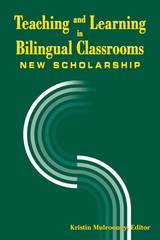 Teaching and Learning in Bilingual Classrooms: New Scholarship
Kristin J. Mulrooney
Gallaudet University Press, 2014 A new initiative known as the Scholarship of Teaching and Learning (SoTL) strives to improve education today by methodically examining and assessing the vital component of classroom interaction. This collection presents research by five professors who adopted SoTL methodology to study their own classrooms at Gallaudet University, a uniquely diverse bilingual institution that employs both American Sign Language (ASL) and written English. The Gallaudet study, called the GSTLI, intended to create an engaged learning community that investigated, reflected upon, and documented strategies that most effectively enhance learning for linguistically diverse, visually oriented populations.
After extensive SoTL training, the GSTLI professors reviewed interaction in their respective classrooms. Through meticulous study of class videos and written assignments in three General Studies Requirements courses for first-year students, the teachers learned how to ensure connecting with students who have a variety of language differences and communication methods.
The other professors assessed bottlenecks in classes on the linguistic structure of ASL, and on criminal justice. The linguistics professor identified the bottleneck as the students’ inability to conceptualize the interrelationship between definitions and examples, a fundamental skill to scientific thinking. In the criminal justice class, the professor saw the need to guide students through linguistic bottlenecks by providing materials in both ASL and English. The successes of the GSTLI presented in this unique volume can benefit other teachers by better preparing them to meet the needs of bilingual diverse learners in more effective ways.
 Teaching and Learning in Jewish Day Schools
Edited by Jonathan B. Krasner, Jon A. Levisohn, and Sharon Avni
Brandeis University Press, 2025 Examines how day schools are educating diverse Jewish youth in a variety of content areas.
Teaching and Learning in Jewish Day Schools offers an important analysis of Jewish day school classrooms today. In light of difficulties initiating, evaluating, and sustaining educational innovation, this volume takes stock of what is happening among students and teachers in contemporary Jewish day school classrooms. The authors of this volume confront and question several bedrock principles of Jewish education to address how day schools intersect with broader societal issues including race and gender. They point to themes and topics that scholars and practitioners are grappling with to explore new potential pathways to evaluating student learning and learning outcomes: assessing core subject areas; understanding the ways social and environmental factors contribute to learning; and studying how race, ethnicity, class, and gender shape student learning and school culture. The chapters address topics relevant to educators working in contemporary Jewish day schools including Zionism, the outcomes of Israel education, Jewish engagement, the experience of Latinx students, community building, and more.
 Teaching and Mentoring Writers in the Sciences: An Evidence-Based Approach
Bethann Garramon Merkle and Stephen B. Heard
University of Chicago Press Blending deep experience, humor, and evidence-based advice, this is an invaluable resource for everyone involved in developing good scientific writers.
Every scientist eventually teaches scientific writing or mentors junior scientists as they develop their writing skills—only to discover that the task is both challenging and remarkably time-consuming. If you are in this position, Teaching and Mentoring Writers in the Sciences is the resource you need, offering approaches that will help you help writers develop their skills more effectively and with less time and effort.
Bethann Garramon Merkle and Stephen B. Heard, both experts in scientific communication, offer evidence-based advice that draws on their own extensive experience as well as on proven tactics from writing studies, science studies, and rhetoric and composition. Shorn of the unfamiliar and off-putting jargon that much pedagogy literature adopts, their advice is engaging and accessible to scientists. As you read, you’ll see where developing writers are coming from; how mastering scientific writing matters to the careers of students who do and don’t continue in academia; how writing occurs and is taught in both undergraduate and graduate curricula; how to find and harness teaching resources that help share the workload; how to teach writing to students who speak English as an additional language; and how to navigate the use (by yourself and by developing writers) of tools from pencils and dictionaries to AI writing assistants. If you teach or mentor scientific writers, this book will help you deliver what your students and mentees need most: clear, effective writing guidance.
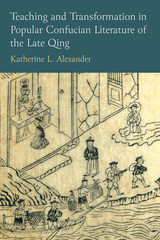 Teaching and Transformation in Popular Confucian Literature of the Late Qing
Katherine L. Alexander
University of Michigan Press, 2025 The Taiping Civil War (1851–1864) was one of the most destructive wars in Chinese history, with the death toll estimated between twenty and thirty million. What visions did survivors have for restoring their fractured society once the war ended? Katherine L. Alexander’s Teaching and Transformation in Popular Confucian Literature of the Late Qing approaches these questions through literature by examining the works of evangelical Confucian teacher Yu Zhi (1809-1874), who gave a voice to the zealous side of conservative Confucian reform efforts before, during, and after the Taiping War. His works offer radical visions of a world that could be restored through collective effort and goodness, while also revealing the shifting nature of power and the cracks in Qing society.
Yu’s works complicate the picture of socio-moral reform, particularly the Confucian mission of jiaohua (teaching and transformation). Though he viewed the disasters of the late Qing as the natural consequence of jiaohua’s failure to compete against socially disruptive media, such as vernacular fiction and theatrical productions, he also wanted reformers to engage closely with these genres. Yu became a vocal advocate of teaching with moral vernacular literature that he believed met commoners at their level. He emphasized the hope that by writing, printing, and performing such texts, every member of his audience could be transformed into teachers themselves, restoring society from the bottom up.
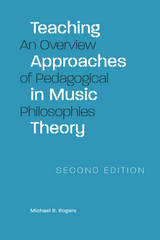 Teaching Approaches in Music Theory, Second Edition: An Overview of Pedagogical Philosophies
Michael R. Rogers
Southern Illinois University Press, 2004 Drawing on decades of teaching experience and the collective wisdom of dozens of the most creative theorists in the country, Michael R. Rogers’s diverse survey of music theory—one of the first to comprehensively survey and evaluate the teaching styles, techniques, and materials used in theory courses—is a unique reference and research tool for teachers, theorists, secondary and postsecondary students, and for private study. This revised edition of Teaching Approaches in Music Theory: An Overview of Pedagogical Philosophies features an extensive updated bibliography encompassing the years since the volume was first published in 1984. In a new preface to this edition, Rogers references advancements in the field over the past two decades, from the appearance of the first scholarly journal devoted entirely to aspects of music theory education to the emergence of electronic advances and devices that will provide a supporting, if not central, role in the teaching of music theory in the foreseeable future. With the updated information, the text continues to provide an excellent starting point for the study of music theory pedagogy. Rogers has organized the book very much like a sonata. Part one, “Background,” delineates principal ideas and themes, acquaints readers with the author’s views of contemporary musical theory, and includes an orientation to an eclectic range of philosophical thinking on the subject; part two, “Thinking and Listening,” develops these ideas in the specific areas of mindtraining and analysis, including a chapter on ear training; and part three, “Achieving Teaching Success,” recapitulates main points in alternate contexts and surroundings and discusses how they can be applied to teaching and the evaluation of design and curriculum. Teaching Approaches in Music Theory emphasizes thoughtful examination and critique of the underlying and often tacit assumptions behind textbooks, materials, and technologies. Consistently combining general methods with specific examples and both philosophical and practical reasoning, Rogers compares and contrasts pairs of concepts and teaching approaches, some mutually exclusive and some overlapping. The volume is enhanced by extensive suggested reading lists for each chapter.
Teaching Arabic as a Foreign Language: Origins, Developments and Current Directions
Andrea Facchin
Amsterdam University Press, 2019 Teaching Arabic as a Foreign Language concentrates on the origins, developments and current directions of the discipline Teaching Arabic as a Foreign Language (TAFL) within the Arab world and partially outside of it during the last 60 years, namely between 1958 and 2018. Considered in this volume are the most influential scholars, authors, educators and those significant works that have contributed to the development of the discipline. In addition, special attention is paid to the TAFL institutes, regarded as epicenters of TAFL activities and important meetings, that allow scholars to gather around the same table and discuss approaches, trends and methods used in the field. All of these aspects converge in one comprehensive study which is enriched by a narration of the main sociopolitical changes that have affected the Middle East in latter-day history.
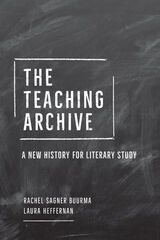 The Teaching Archive: A New History for Literary Study
Rachel Sagner Buurma and Laura Heffernan
University of Chicago Press, 2021 The Teaching Archive shows us a series of major literary thinkers in a place we seldom remember them inhabiting: the classroom. Rachel Sagner Buurma and Laura Heffernan open up “the teaching archive”—the syllabuses, course descriptions, lecture notes, and class assignments—of critics and scholars including T. S. Eliot, Caroline Spurgeon, I. A. Richards, Edith Rickert, J. Saunders Redding, Edmund Wilson, Cleanth Brooks, Josephine Miles, and Simon J. Ortiz. This new history of English rewrites what we know about the discipline by showing how students helped write foundational works of literary criticism and how English classes at community colleges and HBCUs pioneered the reading methods and expanded canons that came only belatedly to the Ivy League. It reminds us that research and teaching, which institutions often imagine as separate, have always been intertwined in practice. In a contemporary moment of humanities defunding, the casualization of teaching, and the privatization of pedagogy, The Teaching Archive offers a more accurate view of the work we have done in the past and must continue to do in the future.
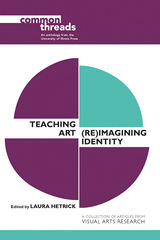 Teaching Art: (Re)Imagining Identity
Laura Hetrick
University of Illinois Press, 2018 A student's personal identity constantly changes as part of the lifelong human process to become someone who matters. Art educators in grades K-16 have a singular opportunity to guide important phases of this development. How can educators create a supportive space for young people to work through the personal and cultural factors influencing their journey? Laura Hetrick draws on articles from the archives of Visual Arts Research to approach the question. Juxtaposing the scholarship in new ways, she illuminates methods that allow educators to help students explore identity through artmaking; to reinforce identity in positive ways; and to enhance marginalized identities. A final section offers suggestions on how educators can use each essay to engage with students who are imagining, and reimagining, their identities in the classroom and beyond. Contributors: D. Ambush, M. S. Bae, J. C. Castro, K. Cosier, C. Faucher, K. Freedman, F. Hernandez, L. Hetrick, K. Jenkins, E. Katter, M. Lalonde, L. Lampela, D. Pariser, A. Pérez Miles, M., and K. Schuler. Laura Hetrick is an assistant professor of art education at the University of Illinois, Urbana-Champaign, and the coeditor of the journal Visual Arts Research.
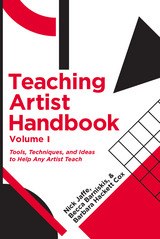 Teaching Artist Handbook, Volume One: Tools, Techniques, and Ideas to Help Any Artist Teach
Nick Jaffe, Becca Barniskis, and Barbara Hackett Cox
University of Chicago Press, 2015 Teaching Artist Handbook is based on the premise that teaching artists have the unique ability to engage students as fellow artists. In their schools and communities, teaching artists put high quality art-making at the center of their practice and open doors to powerful learning across disciplines.
This book is a collection of essays, stories, lists, examples, dialogues, and ideas, all offered with the aim of helping artists create and implement effective teaching based on their own expertise and strengths. The Handbook addresses three core questions: “What will I teach?” “How will I teach it?” and “How will I know if my teaching is working?” It also recognizes that teaching is a dynamic process that requires critical reflection and thoughtful adjustment in order to foster a supportive artistic environment.
Instead of offering rigid formulas, this book is centered on practice—the actual doing and making of teaching artist work. Experience-based and full of heart, the Teaching Artist Handbook will encourage artists of every experience level to create an original and innovative practice that inspires students and the artist.
 Teaching Banned Books: 32 Guides For Children And Teens
Pat R. Scales
American Library Association, 2019 As standard-bearers for intellectual freedom, school and children’s librarians are in ideal positions to collaborate with educators to not only protect the freedom to read but also ensure that valued books which touch upon important topics are not quarantined from the readers for whom they were written. In this best-selling classroom- and library-ready book of discussion guides, thoroughly updated and expanded to include genres such as graphic novels and nonfiction, award-winning champion of children's literature Scales shows that there is a way to teach these books while respecting all views. Also freshened to include only books that are in print, this resource - reprints Judy Blume's stirring introduction from the first edition;
- aids educators and librarians in stimulating the critical thinking skills of young readers aged 9-18 while also encouraging freedom of thought and expression, in either classroom or book club settings;
- spotlights titles dealing with sensitive but vital issues such as bullying, racism, bigotry, making tough choices, other cultures, and our uncertain future;
- offers tips for introducing each book and its associated topics;
- provides open-ended questions for discussion which explore the book as a whole rather than simply its "controversial" aspects, along with research and writing activities; and
- includes short summaries of each book, plus a read-alikes section to keep the conversation going.
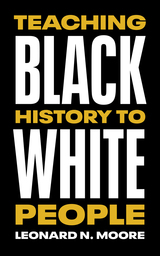 Teaching Black History to White People
By Leonard N. Moore
University of Texas Press, 2021 Leonard Moore has been teaching Black history for twenty-five years, mostly to white people. Drawing on decades of experience in the classroom and on college campuses throughout the South, as well as on his own personal history, Moore illustrates how an understanding of Black history is necessary for everyone. With Teaching Black History to White People, which is “part memoir, part Black history, part pedagogy, and part how-to guide,” Moore delivers an accessible and engaging primer on the Black experience in America. He poses provocative questions, such as “Why is the teaching of Black history so controversial?” and “What came first: slavery or racism?” These questions don’t have easy answers, and Moore insists that embracing discomfort is necessary for engaging in open and honest conversations about race. Moore includes a syllabus and other tools for actionable steps that white people can take to move beyond performative justice and toward racial reparations, healing, and reconciliation.
Teaching Black: The Craft of Teaching on Black Life and Literature
Ana Lara and drea brown
University of Pittsburgh Press, 2021 Teaching Black: The Craft of Teaching on Black Life and Literature presents the experiences and voices of Black creative writers who are also teachers. The authors in this collection engage poetry, fiction, experimental literature, playwriting, and literary criticism. They provide historical and theoretical interventions and practical advice for teachers and students of literature and craft. Contributors work in high schools, colleges, and community settings and draw from these rich contexts in their essays. This book is an invaluable tool for teachers, practitioners, change agents, and presses. Teaching Black is for any and all who are interested in incorporating Black literature and conversations on Black literary craft into their own work.
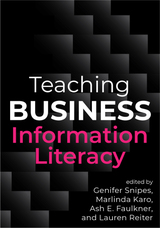 Teaching Business Information Literacy
Genifer Snipes
American Library Association, 2022 Business is currently one of the most popular degree programs among both graduate and undergraduate students, and non-business programs including engineering, design, and pure sciences—all interested in innovation, commercialization, and marketing—are increasingly integrating business training into their curriculum in the name of interdisciplinarity and improved job placement. There is a sustained and growing need for libraries to effectively support business information literacy. At the same time, the resources, research techniques, and assignments that business students need to master often have little in common with a traditional research paper. Teaching Business Information Literacy provides guidance to new business specialists, generalists, and subject librarians in other disciplines being asked to teach business research classes for the first time. Featuring more than 40 practical, classroom-proven lesson plans for one-shot, embedded, and credit-bearing library classes, it’s divided into nine sections: - Basic Business Research
- Finance and Accounting
- Entrepreneurship
- Management
- Marketing
- Specialty Subjects
- Data Literacy/Data Visualization
- Experiential Learning/Career
- Using Technology in the Classroom
Chapters cover such crucial topics as competitive intelligence, market research, financial analysis, ethics, intellectual property, accounting and auditing, supply chain management, job searching, and more. Each one guides you through the background of the topic and activity being taught, pre-class planning and preparation, a step-by-step lesson plan, how to adapt the activity for other institutional contexts, and learning outcomes. Additional supporting materials such as slide decks, worksheets, and game boards are freely available in the ACRL Sandbox (sandbox.acrl.org) and findable with the tag “#bizinfolit.”
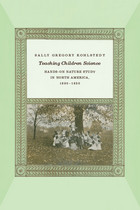 Teaching Children Science: Hands-On Nature Study in North America, 1890-1930
Sally Gregory Kohlstedt
University of Chicago Press, 2010 In the early twentieth century, a curriculum known as nature study flourished in major city school systems, streetcar suburbs, small towns, and even rural one-room schools. This object-based approach to learning about the natural world marked the first systematic attempt to introduce science into elementary education, and it came at a time when institutions such as zoos, botanical gardens, natural history museums, and national parks were promoting the idea that direct knowledge of nature would benefit an increasingly urban and industrial nation.
The definitive history of this once pervasive nature study movement, TeachingChildren Science emphasizes the scientific, pedagogical, and social incentives that encouraged primarily women teachers to explore nature in and beyond their classrooms. Sally Gregory Kohlstedt brings to vivid life the instructors and reformers who advanced nature study through on-campus schools, summer programs, textbooks, and public speaking. Within a generation, this highly successful hands-on approach migrated beyond public schools into summer camps, afterschool activities, and the scouting movement. Although the rich diversity of nature study classes eventually lost ground to increasingly standardized curricula, Kohlstedt locates its legacy in the living plants and animals in classrooms and environmental field trips that remain central parts of science education today.
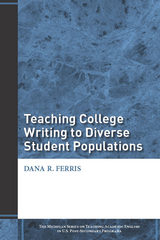 Teaching College Writing to Diverse Student Populations
Dana R. Ferris
University of Michigan Press, 2013 Statistical and anecdotal evidence documents that even states with relatively little ethnic or cultural diversity are beginning to notice and ask questions about long-term resident immigrants in their classes. As shifts in student population become more widespread, there is an even greater need for second language specialists, composition specialists, program administrators, and developers in colleges and universities to understand and adapt to the needs of the changing student audience(s). This book is designed as an introduction to the topic of diverse second language student audiences in U.S. post-secondary education. It is appropriate for those interested in working with students in academic settings, especially those students who are transitioning from secondary to post-secondary education. It provides a coherent synthesis and summary not only of the scope and nature of the changes but of their practical implications for program administration, course design, and classroom instruction, particularly for writing courses. For pre-service teachers and those new(er) to the field of working with L2 student writers, it offers an accessible and focused look at the “audience” issues with many practical suggestions. For teacher-educators and administrators, it offers a resource that can inform their own decision-making.
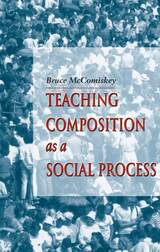 Teaching Composition As A Social Process
Bruce McComiskey
Utah State University Press, 2000 Bruce McComiskey is a strong advocate of social approaches to teaching writing. However, he opposes composition teaching that relies on cultural theory for content, because it too often prejudges the ethical character of institutions and reverts unnecessarily to product-centered practices in the classroom. He opposes what he calls the "read-this-essay-and-do-what-the-author-did method of writing instruction: read Roland Barthes's essay 'Toys' and write a similar essay; read John Fiske's essay on TV and critique a show."
McComiskey argues for teaching writing as situated in discourse itself, in the constant flow of texts produced within social relationships and institutions. He urges writing teachers not to neglect the linguistic and rhetorical levels of composing, but rather to strengthen them with attention to the social contexts and ideological investments that pervade both the processes and products of writing.
A work with a sophisticated theory base, and full of examples from McComiskey's own classrooms, Teaching Composition as a Social Process will be valued by experienced and beginning composition teachers alike.
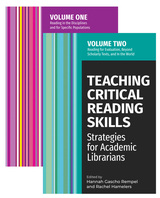 Teaching Critical Reading Skills: Strategies for Academic Librarians Set: 2-Volume Set
Hannah Gascho Rempel
Association of College & Research Libraries, 2023 Teaching Critical Reading Skills: Strategies for Academic Librarians collects the experiences and approaches of librarians who teach reading. In two volumes, librarians share their role in teaching reading—using pedagogical theories and techniques in new and interesting ways, making implicit reading knowledge, skills, and techniques explicit to students, presenting reading as a communal activity, partnering with other campus stakeholders, and leading campus conversations about critical reading. These volumes provide ready-made activities you can add or adapt to your teaching practice. The five sections are arranged by theme: Volume 1 - Part I: Reading in the Disciplines
- Part II: Reading for Specific Populations
Volume 2 - Part III: Reading Beyond Scholarly Texts
- Part IV: Reading to Evaluate
- Part V: Reading in the World
Each of the 45 chapters contains teaching and programmatic strategies, resources, and lesson plans, as well as a section titled “Critical Reading Connection” that highlights each author’s approach for engaging with the purpose of reading critically and advancing the conversation about how librarians can foster this skill. Academic librarians and archivists have a long history of engaging with different types of literacy and acting as a bridge between faculty and students. We understand the different reading needs of specific student populations and the affective challenges with reading that are often shared across learner audiences. We know what types of sources are read, the histories—and needed changes—of how authority has been granted in various fields, how students may be expected to apply what they read in future professional or civic settings, and frequently look beyond our local institutions to think about the larger structural and social justice implications of what is read, how we read, and who does the reading. These volumes can help you make the implicit explicit for learners and teach that reading is both a skill that must be practiced and nurtured and a communal act. Teaching Critical Reading Skills demonstrates librarians’ and archivists’ deep connections to our campus communities and how critical reading instruction can be integrated in a variety of contexts within those communities.
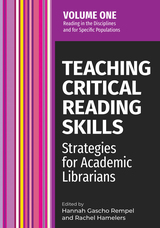 Teaching Critical Reading Skills v1: Strategies for Academic Librarians Volume 1
Hannah Gascho Rempel
Association of College & Research Libraries, 2023 Teaching Critical Reading Skills: Strategies for Academic Librarians collects the experiences and approaches of librarians who teach reading. In two volumes, librarians share their role in teaching reading—using pedagogical theories and techniques in new and interesting ways, making implicit reading knowledge, skills, and techniques explicit to students, presenting reading as a communal activity, partnering with other campus stakeholders, and leading campus conversations about critical reading. These volumes provide ready-made activities you can add or adapt to your teaching practice. The five sections are arranged by theme: Volume 1 - Part I: Reading in the Disciplines
- Part II: Reading for Specific Populations
Volume 2 - Part III: Reading Beyond Scholarly Texts
- Part IV: Reading to Evaluate
- Part V: Reading in the World
Each of the 45 chapters contains teaching and programmatic strategies, resources, and lesson plans, as well as a section titled “Critical Reading Connection” that highlights each author’s approach for engaging with the purpose of reading critically and advancing the conversation about how librarians can foster this skill. Academic librarians and archivists have a long history of engaging with different types of literacy and acting as a bridge between faculty and students. We understand the different reading needs of specific student populations and the affective challenges with reading that are often shared across learner audiences. We know what types of sources are read, the histories—and needed changes—of how authority has been granted in various fields, how students may be expected to apply what they read in future professional or civic settings, and frequently look beyond our local institutions to think about the larger structural and social justice implications of what is read, how we read, and who does the reading. These volumes can help you make the implicit explicit for learners and teach that reading is both a skill that must be practiced and nurtured and a communal act. Teaching Critical Reading Skills demonstrates librarians’ and archivists’ deep connections to our campus communities and how critical reading instruction can be integrated in a variety of contexts within those communities.
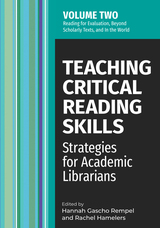 Teaching Critical Reading Skills v2: Strategies for Academic Librarians Volume 2
Hannah Gascho Rempel
Association of College & Research Libraries, 2023 Teaching Critical Reading Skills: Strategies for Academic Librarians collects the experiences and approaches of librarians who teach reading. In two volumes, librarians share their role in teaching reading—using pedagogical theories and techniques in new and interesting ways, making implicit reading knowledge, skills, and techniques explicit to students, presenting reading as a communal activity, partnering with other campus stakeholders, and leading campus conversations about critical reading. These volumes provide ready-made activities you can add or adapt to your teaching practice. The five sections are arranged by theme: Volume 1 - Part I: Reading in the Disciplines
- Part II: Reading for Specific Populations
Volume 2 - Part III: Reading Beyond Scholarly Texts
- Part IV: Reading to Evaluate
- Part V: Reading in the World
Each of the 45 chapters contains teaching and programmatic strategies, resources, and lesson plans, as well as a section titled “Critical Reading Connection” that highlights each author’s approach for engaging with the purpose of reading critically and advancing the conversation about how librarians can foster this skill. Academic librarians and archivists have a long history of engaging with different types of literacy and acting as a bridge between faculty and students. We understand the different reading needs of specific student populations and the affective challenges with reading that are often shared across learner audiences. We know what types of sources are read, the histories—and needed changes—of how authority has been granted in various fields, how students may be expected to apply what they read in future professional or civic settings, and frequently look beyond our local institutions to think about the larger structural and social justice implications of what is read, how we read, and who does the reading. These volumes can help you make the implicit explicit for learners and teach that reading is both a skill that must be practiced and nurtured and a communal act. Teaching Critical Reading Skills demonstrates librarians’ and archivists’ deep connections to our campus communities and how critical reading instruction can be integrated in a variety of contexts within those communities.
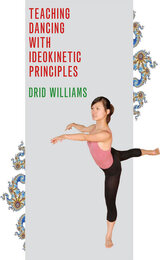 Teaching Dancing with Ideokinetic Principles
Drid Williams
University of Illinois Press, 2011 In examining ideokinesis and its application to the teaching and practice of dancing, Drid Williams introduces readers to the work of Dr. Lulu Sweigard (1895–1974), a pioneer of ideokinetic principles. Drawing on her experiences during private instructional sessions with Sweigard over a two-year span, Williams discusses methods using imagery for improving body posture and alignment for ease of movement. Central to Williams's own teaching methods is the application of Sweigard's principles and general anatomical instruction, including how she used visual imagery to help prevent bodily injuries and increasing body awareness relative to movement. Williams also emphasizes the differences between kinesthetic (internal) and mirror (external) imagery and shares reactions from professional dancers who were taught using ideokinesis. Williams's account of teaching and practicing ideokinesis is supplemented with essays by Sweigard, William James, and Jean-Georges Noverre on dancing, posture, and habits. Teaching Dancing with Ideokinetic Principles offers an important historical perspective and valuable insights from years of teaching experience into how ideokinesis can shape a larger philosophy of the dance.
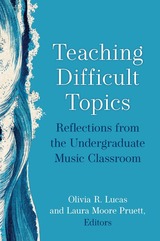 Teaching Difficult Topics: Reflections from the Undergraduate Music Classroom
Olivia R. Lucas and Laura Moore Pruett
University of Michigan Press, 2024 Teaching Difficult Topics provides a series of on-the-ground reflections from college music instructors working in a wide variety of institutional settings about their approaches to inclusive, supportive pedagogy in the music classroom. Although some imagine the music classroom to be an apolitical space, instructors find themselves increasingly in need of resources for incorporating issues of race and ethnicity, gender and sexuality, and historical trauma into their classrooms in ways that support student learning and safeguard their classroom communities.
The teaching reflections in Teaching Difficult Topics examine difficult themes that fall into three primary categories: subjects that instructors sense to be controversial or emotionally challenging to discuss, those that derive from or intersect with real-world events that are difficult to process, and bigger-picture discussions of how music studies often focuses on dominant narratives while overlooking other perspectives. Some chapters offer practical guidance, lesson plans, and teaching materials to enable instructors to build discussions of race, gender, sexuality, and traumatic histories into their own classrooms; others take a more global view, reflecting on the importance and relevance of teaching these difficult topics and on how to respond in the music classroom when external events disrupt daily life.
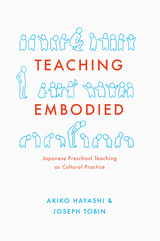 Teaching Embodied: Cultural Practice in Japanese Preschools
Akiko Hayashi and Joseph Tobin
University of Chicago Press, 2015 When we look beyond lesson planning and curricula—those explicit facets that comprise so much of our discussion about education—we remember that teaching is an inherently social activity, shaped by a rich array of implicit habits, comportments, and ways of communicating. This is as true in the United States as it is in Japan, where Akiko Hayashi and Joseph Tobin have long studied early education from a cross-cultural perspective. Taking readers inside the classrooms of Japanese preschools, Teaching Embodied explores the everyday, implicit behaviors that form a crucially important—but grossly understudied—aspect of educational practice.
Akiko Hayashi and Joseph Tobin embed themselves in the classrooms of three different teachers at three different schools to examine how teachers act, think, and talk. Drawing on extended interviews, their own real-time observations, and hours of video footage, they focus on how teachers embody their lessons: how they use their hands to gesture, comfort, or discipline; how they direct their posture, gaze, or physical location to indicate degrees of attention; and how they use the tone of their voice to communicate empathy, frustration, disapproval, or enthusiasm. Comparing teachers across schools and over time, they offer an illuminating analysis of the gestures that comprise a total body language, something that, while hardly ever explicitly discussed, the teachers all share to a remarkable degree. Showcasing the tremendous importance of—and dearth of attention to—this body language, they offer a powerful new inroad into educational study and practice, a deeper understanding of how teaching actually works, no matter what culture or country it is being practiced in.
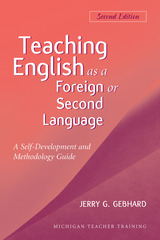 Teaching English as a Foreign or Second Language, Second Edition: A Teacher Self-Development and Methodology Guide
Jerry G. Gebhard
University of Michigan Press, 2006 Teaching English as a Foreign or Second Language, Second Edition, is designed for those new to ESL/EFL teaching and for self-motivated teachers who seek to maximize their potential and enhance the learning of their students. This guide provides basic information that ESL/EFL teachers should know before they start teaching and many ideas on how to guide students in the skills of listening, speaking, reading, and writing. It stresses the multifaceted nature of teaching the English language to non-native speakers and is based on the real experiences of teachers.
The second edition of Teaching English as a Foreign or Second Language includes a wider range of examples to coincide with a variety of teaching contexts-from K-12 schools, to university intensive language programs and refugee programs. It is also updated with discussions of technology throughout, and it considers ways in which technology can be used in teaching language skills. Sources for further study are included in each chapter and in the appendixes.
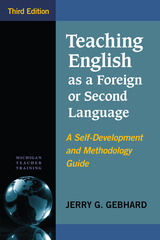 Teaching English as a Foreign or Second Language, Third Edition: A Self-Development and Methodology Guide
Jerry G. Gebhard
University of Michigan Press, 2017 Like previous editions, the third edition is an ideal teacher development text for pre-service and in-service EFL/ESL teachers, as well as a guide for those who find themselves teaching English overseas but who do not have a master's in TESOL. This edition has the same three major sections: (1) Self-Development, Exploration, and Settings; (2) Principles of EFL/ESL Teaching; and (3) Teaching Language Skills. New to this edition are: - a chapter on digital literacy, technology, and teaching
- the addition of technology issues as they relate to the teaching of the various skills in Part 3
- discussions of task-based teaching, student presentations, how corpus linguistics can inform teaching, metacognitive reading strategies, collaborative writing, assessing writing, and the teaching of grammar.
The lists of recommended resources that appear at the end of each chapter have been updated, and all research and pedagogical practices have been revised and updated.
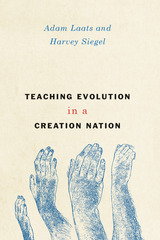 Teaching Evolution in a Creation Nation
Adam Laats and Harvey Siegel
University of Chicago Press, 2016 No fight over what gets taught in American classrooms is more heated than the battle over humanity’s origins. For more than a century we have argued about evolutionary theory and creationism (and its successor theory, intelligent design), yet we seem no closer to a resolution than we were in Darwin’s day. In this thoughtful examination of how we teach origins, historian Adam Laats and philosopher Harvey Siegel offer crucial new ways to think not just about the evolution debate but how science and religion can make peace in the classroom.
Laats and Siegel agree with most scientists: creationism is flawed, as science. But, they argue, students who believe it nevertheless need to be accommodated in public school science classes. Scientific or not, creationism maintains an important role in American history and culture as a point of religious dissent, a sustained form of protest that has weathered a century of broad—and often dramatic—social changes. At the same time, evolutionary theory has become a critical building block of modern knowledge. The key to accommodating both viewpoints, they show, is to disentangle belief from knowledge. A student does not need to believe in evolution in order to understand its tenets and evidence, and in this way can be fully literate in modern scientific thought and still maintain contrary religious or cultural views. Altogether, Laats and Siegel offer the kind of level-headed analysis that is crucial to finding a way out of our culture-war deadlock.
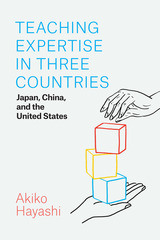 Teaching Expertise in Three Countries: Japan, China, and the United States
Akiko Hayashi
University of Chicago Press, 2022 A comparison of the development of expertise in preschool teaching in China, Japan, and the United States.
In Teaching Expertise in Three Countries, Akiko Hayashi shows how teachers from Japan, China, and the United States think about what it means to be an expert teacher. Based on interviews with teachers conducted over the span of fifteen years and videos taken in their classrooms, Hayashi gives us a valuable portrait of expert teachers in the making. While Hayashi’s research uncovered cultural variations in the different national contexts, her analysis of how teachers adapted their pedagogy throughout their careers also revealed many cross-national similarities. Younger teachers often describe themselves as being in a rush, following scripts, and “talking too much,” while experienced teachers describe themselves as being quieter, knowing children better, and being more present.
Including a foreword by scholar of early childhood education Joseph Tobin, Teaching Expertise in Three Countries provides a foundation for understanding the sequence and pathways of development over the first decade of teaching in three national contexts, demonstrating the value of the field of comparative education in the process.
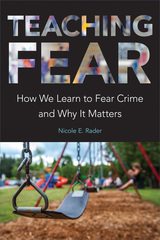 Teaching Fear: How We Learn to Fear Crime and Why It Matters
Nicole E. Rader
Temple University Press, 2023 Where do lessons of “stranger danger” and safety come from—and do they apply differently for women? A gender-fear paradox shows that although women are less likely to be victims of most crimes (sexual assault aside), their fear of crime is greater. Moreover, girls and women—especially White women—are taught to fear the wrong things and given impossible tools to prevent victimization. In Teaching Fear, Nicole Rader zooms in on the social learning process, tracing the ways that families, schools, and the media have become obsessed with crime myths, especially regarding girls and women. Based on in-depth research and family studies, Rader reveals the dubious and dangerous origins of many of the most prominent safety guidelines that teach young girls to be more afraid of crime. These guidelines carry over to adulthood, influencing women’s behaviors and the way they order their worlds, with dangerous consequences. As women teach their learned behavior and conditioned fear to others, gendered crime myths are recirculated from generation to generation, making them a staple in our society. Teaching Fear includes suggestions for taking precautionary measures and crime prevention strategies. Rader also provides guidance for instilling safety values and demonstrating how we can “teach fear better” to break this cycle and truly create greater security.
Teaching Foreign Language Skills: Second Edition
Wilga M. Rivers
University of Chicago Press, 1981 Since its original publication in 1968, Rivers's comprehensive and practical text has become a standard reference for both student teachers and veteran instructors. All who wish to draw from the most recent thinking in the field will welcome this new edition. Methodology is appraised, followed up by discussions on such matters as keeping students of differing abilities active, evaluating textbooks, using language labs creatively, and preparing effective exercises and drills. The author ends each chapter of this new edition with questions for research and discussion—a useful classroom tool—and provides an up-to-date bibliography that facilitates further understanding of such matters as the bilingual classroom.
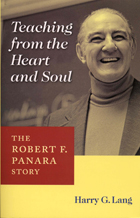 Teaching from the Heart and Soul: The Robert F. Panara Story
Harry G. Lang
Gallaudet University Press, 2007 The Sixth Volume in the Deaf Lives Series
Robert F. Panara lost his hearing from spinal meningitis in 1931 at the age of ten. However, he could read and write, and with his friends’ help, Bob (as he was known), made it through high school. His new solitude created a new passion – reading, reading, and reading. The stage was set for the emergence of one of the great deaf educators in modern time, a life fully captured in Harry G. Lang’s Teaching from the Heart and Soul: The Robert F. Panara Story.
Bob Panara’s many achievements began after his discovery of Gallaudet College in the 1940s. There, he wrote “The Significance of the Reading Problem,” which first expressed his belief that teaching “comes from the heart and soul.” The article secured him his first job at the New York School for the Deaf in White Plains. Bob returned to teach at Gallaudet College from 1948 until 1965, when he left to help found the National Technical Institute for the Deaf (NTID) and the National Theatre of the Deaf (NTD) — all in the same year. He continued to expand arts and literature at NTID until his retirement in 1987.
Bob Panara’s genius resides in the people he inspired with his vivacious teaching style. He believed ardently in involving students, that they should “be the book.” Former students tell story after story about his fabulous interpretations of drama and poetry, a legacy confirmed by his own story in Teaching from the Heart and Soul.
 Teaching Gender with Libraries and Archives
Sara De Jong
Central European University Press, 2014 This volume invites teachers and students in gender and women’s studies to engage with the library not as an instrument for knowledge, but as a subject and object of knowledge in its own right. The authors and editors had three specific aims. Firstly, to highlight how Gender Studies and the institutions and practices that preserve and disseminate feminist knowledge are historically and systematically intertwined. Secondly, the necessity to reflect on the symbolic meaning and practical institutionalization of libraries and archives as they are undergoing profound transformations under the influence of new (technological) developments; finally, to engage with the question of how these transformations give way to new ways of producing, preserving and disseminating feminist knowledge through practices situated between the force fields of cultural and academic institutions, material and virtual culture, and the collective imaginary.This book is a part of the series Teaching with Gender, European Women’s Studies in International and Interdisciplinary Classrooms, jointly published with ATGENDER, The European Association for Gender Research, Education and Documentation.
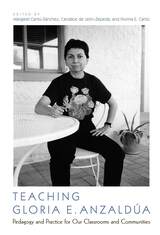 Teaching Gloria E. Anzaldúa: Pedagogy and Practice for Our Classrooms and Communities
Edited by Margaret Cantú-Sánchez, Candace de León-Zepeda, Norma E. Cantú
University of Arizona Press, 2020 Gloria Evangelina Anzaldúa—theorist, Chicana, feminist—famously called on scholars to do work that matters. This pronouncement was a rallying call, inspiring scholars across disciplines to become scholar-activists and to channel their intellectual energy and labor toward the betterment of society. Scholars and activists alike have encountered and expanded on these pathbreaking theories and concepts first introduced by Anzaldúa in Borderlands/La frontera and other texts.
Teaching Gloria E. Anzaldúa is a pragmatic and inspiring offering of how to apply Anzaldúa’s ideas to the classroom and in the community rather than simply discussing them as theory. The book gathers nineteen essays by scholars, activists, teachers, and professors who share how their first-hand use of Anzaldúa’s theories in their classrooms and community environments.
The collection is divided into three main parts, according to the ways the text has been used: “Curriculum Design,” “Pedagogy and Praxis,” and “Decolonizing Pedagogies.” As a pedagogical text, Teaching Gloria E. Anzaldúa also offers practical advice in the form of lesson plans, activities, and other suggested resources for the classroom. This volume offers practical and inspiring ways to deploy Anzaldúa’s transformative theories with real and meaningful action.
Contributors
Carolina E. Alonso
Cordelia Barrera
Christina Bleyer
Altheria Caldera
Norma E. Cantú
Margaret Cantú-Sánchez
Freyca Calderon-Berumen
Stephanie Cariaga
Dylan Marie Colvin
Candace de León-Zepeda
Miryam Espinosa-Dulanto
Alma Itzé Flores
Christine Garcia
Patricia M. García
Patricia Pedroza González
María del Socorro Gutiérrez-Magallanes
Leandra H. Hernández
Nina Hoechtl
Rían Lozano
Socorro Morales
Anthony Nuño
Karla O’Donald
Christina Puntasecca
Dagoberto Eli Ramirez
José L. Saldívar
Tanya J. Gaxiola Serrano
Verónica Solís
Alexander V. Stehn
Carlos A. Tarin
Sarah De Los Santos Upton
Carla Wilson
Kelli Zaytoun
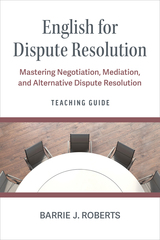 The Teaching Guide for English for Dispute Resolution: Mastering Negotiation, Mediation, and Alternative Dispute Resolution
Barrie J. Roberts
University of Michigan Press, 2025 The Teaching Guide for English for Dispute Resolution shows ESL/ESP instructors how to use the textbook to teach negotiation, mediation, professional-level communication, and the field of Alternative Dispute Resolution (ADR). Designed to support instructors who may not have formal background or training in these topics, the book provides separate guidance for ESP and ESL instructors. It shows ESP instructors how to use the textbook in their current Legal English or Business English courses or in stand-alone negotiation or mediation courses. It advises ESL instructors on how to use these topics as a theme for multi-skill courses or as an engaging new way to develop students’ cross-cultural communication, problem-solving, critical thinking, teamwork, leadership, and other soft skills in their current courses. The textbook and guide are based on over twenty years of classroom experience with high-intermediate to advanced ESL and ESP students, from undergrads to LL.M. students, and on teacher-training workshops offered at places such as UC Berkeley, TESOL, and CATESOL. Each chapter of the textbook provides a ready-made lesson plan with a sample dispute, warm-up questions, background readings, follow-up questions, activities, and reflections, and The Teaching Guide supplements each chapter with: - Support in the form of teaching tips, lesson plans, additional activities or role-plays, assessment suggestions, and resources for further exploration.
- Separate guidance for ESL and Legal English/Business English instructors that helps them select the material and activities best suited to their students’ interests and needs.
- Resources such as sample syllabi and activities with step-by-step instructions that make it easy to start teaching the textbook.
- An online companion site where instructors can download and send activities and role-plays directly to their students.
Teaching History in the Digital Age
T. Mills Kelly
University of Michigan Press, 2013 Although many humanities scholars have been talking and writing about the transition to the digital age for more than a decade, only in the last few years have we seen a convergence of the factors that make this transition possible: the spread of sufficient infrastructure on campuses, the creation of truly massive databases of humanities content, and a generation of students that has never known a world without easy Internet access.
Teaching History in the Digital Age serves as a guide for practitioners on how to fruitfully employ the transformative changes of digital media in the research, writing, and teaching of history. T. Mills Kelly synthesizes more than two decades of research in digital history, offering practical advice on how to make best use of the results of this synthesis in the classroom and new ways of thinking about pedagogy in the digital humanities.
 Teaching in America: The Slow Revolution
Gerald Grant and Christine E. Murray
Harvard University Press, 1999 If the essential acts of teaching are the same for schoolteachers and professors, why are they seen as members of quite separate professions? Would the nation's schools be better served if teachers shared more of the authority that professors have long enjoyed? Will a slow revolution be completed that enables schoolteachers to take charge of their practice--to shoulder more responsibility for hiring, mentoring, promoting, and, if necessary, firing their peers?
This book explores these questions by analyzing the essential acts of teaching in a way that will help all teachers become more thoughtful practitioners. It presents portraits of teachers (most of them women) struggling to take control of their practice in a system dominated by an administrative elite (mostly male). The educational system, Gerald Grant and Christine Murray argue, will be saved not by better managers but by better teachers. And the only way to secure them is by attracting talented recruits, developing their skills, and instituting better means of assessing teachers' performance.
Grant and Murray describe the evolution of the teaching profession over the last hundred years, and then focus in depth on recent experiments that gave teachers the power to shape their schools and mentor young educators. The authors conclude by analyzing three equally possible scenarios depicting the role of teachers in 2020.
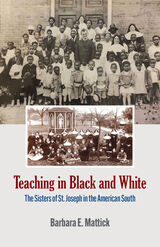 Teaching in Black and White: The Sisters of St. Joseph in the American South
Barbara E. Mattick
Catholic University of America Press, 2022 Teaching in Black and White: The Sisters of St. Joseph in the American South discusses the work of the Sisters of St. Joseph of (the city of) St. Augustine, who came to Florida from France in 1866 to teach newly freed blacks after the Civil War, and remain to this day. It also tells the story of the Sisters of St. Joseph of Georgia, who sprang from the motherhouse in St. Augustine.
A significant part of the book is a comparison of the Sisters of St. Josephs’ work against that of their major rivals, missionaries from the Protestant American Missionary Association. Using letters the Sisters wrote back to their motherhouse in France, the book provides rare glimpses into the personal and professional (pun intended) lives of these women religious in St. Augustine and other parts of Florida and Georgia, from the mid-nineteenth century through the era of anti-Catholicism in the early twentieth century South. It carries the story through 1922, the end of the pioneer years of the Sisters of St. Josephs’ work in Florida, and the end of Sisters of St. Joseph of Georgia’s existence as a distinct order. Through the lenses of Catholicism, Florida and Southern history, gender, and race, the book addresses the Protestant concept of domesticity and how it was reinforced in Catholic terms by women who seemingly defied the ideal. It also relates the Sisters’ contributions in shaping life in the South during Reconstruction as they established elite academies and free schools, created orphanages, ministered to all during severe yellow fever epidemics, and fought the specter of anti-Catholicism as it crept across the rural regions of the country. To date, little has been written about Catholics in the South, much less the women religious who served there. This book helps to fill that gap.
Teaching in Black and White provides rare glimpses into the personal and professional lives of women religious in Florida and Georgia, from the mid-nineteenth to early twentieth-century.
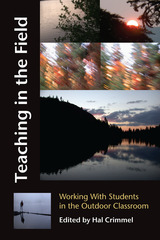 Teaching In The Field
Hal Crimmel
University of Utah Press, 2003 Taking students out of the classroom and into a variety of settings, ranging from remote wilderness sites to urban or built environments is now recognized as a valuable means of teaching ecological concepts and environmental values. But field studies are also a way of encouraging explorations across the curriculum, enhancing the teaching of life sciences, literature, and creative writing. Teaching in the Field is the first volume to specifically survey field studies conducted through colleges and universities. The essays, arranged into three sections, offer rationales, pedagogical strategies, and foundational advice and information that broaden and strengthen the collective knowledge of this increasingly popular means of instruction. The essays present theoretical information within engaging, candid narratives that report on various aspects of field experiences, whether hour-long excursions or month-long trips. Teachers of environmental studies, of English, composition, and creative writing, and of allied humanities and science disciplines, will find here a wealth of success stories and cautionary tales to guide them in envisioning their own outdoor classrooms.
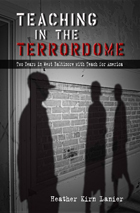 Teaching in the Terrordome: Two Years in West Baltimore with Teach for America
Heather Kirn Lanier
University of Missouri Press, 2012 Only 50 percent of kids growing up in poverty will earn a high school diploma. Just one in ten will graduate college. Compelled by these troubling statistics, Heather Kirn Lanier joined Teach For America (TFA), a program that thrusts eager but inexperienced college graduates into America’s most impoverished areas to teach, asking them to do whatever is necessary to catch their disadvantaged kids up to the rest of the nation. With little more than a five-week teacher boot camp and the knowledge that David Simon referred to her future school as “The Terrordome,” the altruistic and naïve Lanier devoted herself to attaining the program’s goals but met obstacles on all fronts. The building itself was in such poor condition that tiles fell from the ceiling at random. Kids from the halls barged into classes all day, disrupting even the most carefully planned educational activities. In the middle of one lesson, a wandering student lit her classroom door on fire. Some colleagues, instantly suspicious of TFA’s intentions, withheld their help and supplies. (“They think you’re trying to ‘save’ the children,” one teacher said.) And though high school students can be by definition resistant, in west Baltimore they threw eggs, slashed tires, and threatened teachers’ lives. Within weeks, Lanier realized that the task she was charged with—achieving quantifiable gains in her students’ learning—would require something close to a miracle. Superbly written and timely, Teaching in the Terrordome casts an unflinching gaze on one of America’s “dropout factory” high schools. Though Teach For America often touts its most successful teacher stories, Lanier’s powerful memoir illuminates a more common experience of “Teaching For America” with thoughtful complexity, a poet’s eye, and an engaging voice. As hard as Lanier worked to become a competent teacher, she found that in “The Terrordome”, idealism wasn’t enough. To persevere, she had to rely on grit, humility, a little comedy, and a willingness to look failure in the face. As she adjusted to a chaotic school administration, crumbling facilities, burned-out colleagues, and students who perceived their school for the failure it was, she gained perspective on the true state of the crisis TFA sets out to solve. Ultimately, she discovered that contrary to her intentions, survival in the so-called Charm City was a high expectation.
 Teaching India–Pakistan Relations: Teachers' Attitudes, Practices and Agency
Kusha Anand
University College London, 2023 A study of how the fraught relationship between India and Pakistan is taught to students in both countries.
The rivalry between India and Pakistan began with the British withdrawal from the British Indian Empire in 1947 and the sudden partition of India immediately afterward. Seventy-five years later, it remains powerful. While the countries share a long history and considerable socio-cultural affinity, relations since Partition have been marked by three wars, constant border skirmishes, and a deep distrust that permeates both societies. In each, teaching about those relations is weighted with political and cultural significance, and research shows that curricula have been used deliberately to shape the understanding of new generations.
This book explores the attitudes and pedagogical decision-making of teachers in India and Pakistan when teaching India–Pakistan relations. Situating teachers in the context of reformed textbooks and curriculums in both countries that explicitly advocate critical thinking and social cohesion, Kusha Anand explores how far teachers have enacted these changes in their classrooms. What she finds is that while there is progress towards the stated goals, teachers in both countries face pressures from the interests of school and state, and often miss opportunities to engage with multiple perspectives and stereotypes in their classrooms.
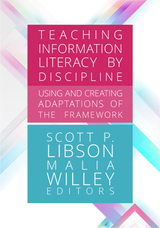 Teaching Information Literacy by Discipline: Using and Creating Adaptations of the Framework
Scott P. Libson
Association of College & Research Libraries, 2025 The Framework for Information Literacy for Higher Education has broad applicability that can be customized for different areas of study. Librarians have created companion documents and subject-specific information literacy applications that show the ways the Framework applies to their various fields. In nine thorough sections, Teaching Information Literacy by Discipline shows the great diversity in how librarians understand, adapt, and apply the Framework. It explores how frames are applied when drafting learning outcomes, building research guides, crafting assignments, designing curricula for a particular discipline, and more. - Arts
- Writing
- Humanities
- Interdisciplinary Studies
- Social Sciences
- Business
- Education and Behavioral Studies
- Health
- Sciences
Teaching Information Literacy by Discipline underlines the breadth of the Framework’s applicability and expands our understanding of information literacy through diverse interpretations. Subject, liaison, instruction, and new librarians will find many ideas in how other disciplines have adapted the Framework, as well as how to translate information literacy concepts for teaching faculty.
 Teaching Information Literacy Reframed: 50+ Framework-Based Exercises for Creating Information-Literate Learners
Joanna M. Burkhardt
American Library Association, 2016 The six threshold concepts outlined in the Framework for Information Literacy for Higher Education are not simply a revision of ACRL's previous Information Literacy Competency Standards for Higher Education. They are instead an altogether new way of looking at information literacy. In this important new book, bestselling author and expert instructional librarian Burkhardt decodes the Framework, putting its conceptual approach into straightforward language while offering more than 50 classroom-ready Framework-based exercises. Guiding instructors towards helping students cross each threshold, this book - discusses the history of the development of the Framework document and briefly deconstructs the six threshold concepts;
- thoroughly addresses each threshold concept, scaffolding from the beginner level to the intermediate level;
- includes exercises that can be used in the one-shot timeframe as well as others designed for longer class sessions and semester-long courses;
- offers best practices in creating learning outcomes, assessments, rubrics, and teaching tricks and tips; and
- looks at how learning, memory, and transfer of learning applies to the teaching of information literacy.
Offering a solid starting point for understanding and teaching the six threshold concepts in the Framework, Burkhardt's guidance will help instructors create their own local information literacy programs.
Teaching Israel: Studies of Pedagogy from the Field
Edited by Sivan Zakai and Matt Reingold
Brandeis University Press, 2024 An edited volume that grapples with the complex issues and conflicts that face instructors developing curricula about Israel.
Jewish Americans are divided in their views on Israel. While scholars have outlined philosophical principles to guide educators who teach about Israel, there has been less scholarship focused on the pedagogy surrounding the country. This book resituates teaching—the questions, dilemmas, and decision-making that teachers face—as central to both Israel studies and Israel education. Contributors illuminate how educators from differing pedagogical orientations, who teach in a range of educational settings learn, understand, undertake, and ultimately improve the work of teaching Israel. The volume also looks at the professional support and learning opportunities teachers may need to engage with these pedagogical questions.
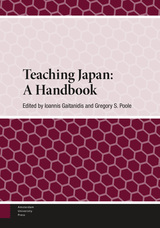 Teaching Japan: A Handbook
Ioannis Gaitanidis
Amsterdam University Press, 2024 This book aims to offer ideas and examples of pedagogy in the undergraduate classroom. The basic premise taken by the authors begins with a question: What if stereotypes surrounding Japan were not pushed to the margins in teaching but took center stage and were exposed for the multiple ways that they can be used to learn not only about “Japan” but of various scholarly disciplines? The task then becomes constructing ways to challenge essentialist notions that do not seek merely to deny, but to shift the conversation constructively by encouraging engagement with a theoretical field from which to acquire tools to critically and effectively evaluate stereotypes of Japan or other societies. The result is a collection of carefully crafted case studies of syllabi that showcase pedagogies aimed at the deconstruction of concepts such as “Japan,” “Japanese,” or “Japanese society” while at the same time offering skills of inquiry that transcend the topics being deconstructed. This handbook is a source of ideas from colleagues in a variety of disciplinary and institutional settings, who are tackling the same issues current or future teachers who plan to use case studies from Japan in their lectures.
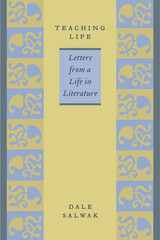 Teaching Life: Letters from a Life in Literature
Dale Salwak
University of Iowa Press, 2008 Part epistolary memoir, part handbook, Teaching Life reflects on more than three decades of teaching literature and touching the lives of students. Both a reflection on a life in literature and a primer on teaching as a vocation, this soul-stirring work also provides behind-the-scenes stories of many of the authors who have influenced Dale Salwak’s career.
Written in response to the sudden death of one of his students, who died tragically in an automobile accident on her way to Salwak’s office to talk over her career plans, Teaching Life is an effort to impart lessons to the next generation of teachers: “It was the suddenness of her death, I think, along with the utter loss of so much potential, which struck me forcibly, and I found myself wondering if anything I had said in class had made a difference in her too-short life or, for that matter, in the lives of any of my students.”
By turns analytical, reflective, and exhortatory, Teaching Life unselfconsciously captures the fascination, enlightenment, and sheer joy that literary studies can offer professors and students. It also implicitly speaks to society's prevailing—and disturbing—prejudice against the profession.
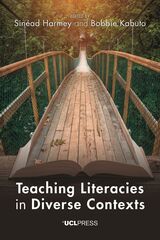 Teaching Literacies in Diverse Contexts
Edited by Sinéad Harmey and Bobbie Kabuto
University College London, 2023 A practical guide to teaching literacy in all its varied contexts.
Literacy education doesn’t just happen in schools, with young children. It can take place in many locations, and at many different points in people’s lives. Literacy educators, therefore, need flexibility and a deep toolbox to meet their students’ diverse needs, regardless of whether they work in traditional school and college settings or in other environments with varied populations. Teaching Literacy in Diverse Contexts shows how practical experiences can be used in creative ways to support educator development for teaching literacy in a global context. Mentorship between a developing literacy educator and an experienced teacher educator is central to the book, and to the practical experiences in training or professional development that it focuses on. Chapters share the creative solutions discovered during mentorship that supported developing literacy educators to teach with authenticity in a number of contexts, including the adult learning sector, a rural community in Africa, and alongside parents of very sick children. Together, the chapters build a crucial resource for preparing a broad range of literacy educators to teach literacy in many contexts where policy on how best to teach reading and writing to diverse student bodies ebbs and flows.
 Teaching Literature: What Is Needed Now
James Engell
Harvard University Press, 1988 Hugh Kenner, Helen Vendler, Harry Levin, Nathan A. Scott, Jr., Barbara Johnson, J. Hillis Miller, and seven other scholars, critics, and metacritics at the forefront of intellectual developments in their fields offer provocative statements on the teaching of literature and on their own practices as teachers. The authors, differing widely in their areas of interest and their approaches to literature, stress an inherent relation between the classroom and their published writings, integrating teaching strategies with critical or theoretical positions.
Teaching is seen as an essential part of their work at large rather than a separate discipline with other methods and aims. Ranging over such topics as Shakespeare, feminism, composition, the teaching of poetry, and interpretation, the essays are mostly personal: descriptive, not prescriptive. From the writers' experiences, both positive and negative, much can be learned about ways of approaching a work of literature, of reading and understanding a text, as well as ways of helping students to do the same.
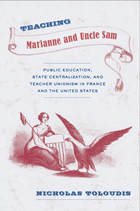 Teaching Marianne and Uncle Sam: Public Education, State Centralization, and Teacher Unionism in France and the United States
Nicholas Toloudis
Temple University Press, 2012 Offering the first systematic, comparative examination of the origins of teachers’ unions in two countries—France and the United States—Teaching Marianne and Uncle Sam shows how teachers’ unions came into existence not because of the willful efforts of particular actors, but over the course of decades of conflict over the proper role of professional educators in public politics. Nicholas Toloudis traces teacher unionism back to the first efforts of governments to centralize public education. He carefully documents how centralization created new understandings of the role of teachers in their societies and generated new sources of conflict within teachers’ corps. Using rare archival source materials, Toloudis illustrates how these internal conflicts became salient in teachers’ battles with governments over their legitimate right to exist as collective claim-makers within the polity. In the series Politics, History, and Social Change, edited by John C. Torpey
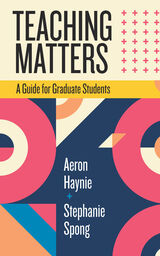 Teaching Matters: A Guide for Graduate Students
Aeron Haynie
West Virginia University Press, 2022 A practical and evidence-based teaching guide for graduate students across all fields. In a book written directly for graduate students that includes graduate student voices and experiences, Aeron Haynie and Stephanie Spong establish why good teaching matters and offer a guide to helping instructors-in-training create inclusive and welcoming classrooms. Teaching Matters is informed by recent research while being grounded in the personal perspectives of current and past graduate students in many disciplines. Graduate students can use this book independently to prepare to teach their courses, or it can be used as a guide for a teaching practicum. With a just-in-time checklist for graduate students who are assigned to teach courses right before the semester starts, step-by-step directions for writing a compelling teaching philosophy, and an emphasis on teaching well regardless of modality, Teaching Matters will remain relevant for graduate students throughout their careers.
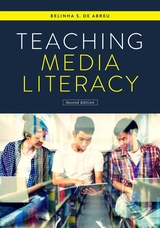 Teaching Media Literacy
Belinha S. De Abreu
American Library Association, 2019 Foreword by Michelle Ciulla Lipkin, Executive Director, National Association for Media Literacy Education
Preface by Denise E. Agosto Though media literacy and information literacy are intertwined, there are important differences; and there has never been a more urgent need for an incisive examination of the crucial role librarians and other educators can play in teaching the skills necessary to access, analyze, evaluate, and create media. Media literate youth and adults are better able to understand the complex messages emanating from television, movies, radio, the internet, news outlets, magazines, books, billboards, video games, music, and all other forms of media. In this book, international expert De Abreu melds advice from a diverse array of practitioners and subject experts with her own research findings to examine how consuming media and technology impacts the learning of K–12 students, tackling such paramount issues as - fake news/alternative facts;
- critical thinking
- digital literacy and digital citizenship;
- social inclusion and equity;
- global interconnectivity; and
- social justice and advocacy.
Teaching Mindful Writers
Brian Jackson
Utah State University Press, 2020 Teaching Mindful Writers introduces new writing teachers to a learning cycle that will help students become self-directed writers through planning, practicing, revising, and reflecting. Focusing on the art and science of instructing self-directed writers through major writing tasks, Brian Jackson helps teachers prepare students to engage purposefully in any writing task by developing the habits of mind and cognitive strategies of the mindful writer. Relying on the most recent research in writing studies and learning theory, Jackson gives new teachers practical advice about setting up writing tasks, using daily writing, leading class discussions, providing feedback, joining teaching communities, and other essential tools that should be in every writing teacher’s toolbox. Teaching Mindful Writers is a timely, fresh perspective on teaching students to be self-directed writers.
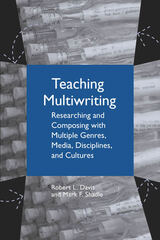 Teaching Multiwriting: Researching and Composing with Multiple Genres, Media, Disciplines, and Cultures
Robert L. Davis and Mark F. Shadle
Southern Illinois University Press, 2007 Formulaic ways to train students in composition and rhetoric are no longer effective, say authors Robert L. Davis and Mark F. Shadle. Scholar-teachers must instead reinvent the field from the inside. Teaching Multiwriting: Researching and Composing with Multiple Genres, Media, Disciplines, and Cultures presents just such a reinvention with multiwriting, an alternative, open approach to composition. Seeking to open the minds of both writers and readers to new understandings, the authors argue for the supplanting of the outdated research paper assignment with research projects that use multiple forms to explore questions that cannot be fully answered.
This innovative volume, geared to composition teachers at all levels, includes sixteen helpful illustrations and provides classroom exercises and projects for each chapter.
The Teaching of Arabic as a Foreign Language: Issues and Directions
Mahmoud Al-Batal, Editor
Georgetown University Press, 1995 In this volume leading teachers of Arabic, many of whom have written influential textbooks for advanced learners, explore the realities and challenges of teaching Arabic as a foreign language. Topics covered include the state of the Arabic teaching profession; the institutional challenges in U.S. and study-abroad programs; the teaching of various skills such as writing, reading, speaking, and listening; the varieties of Arabic and their relevance in the classroom; the uses of technology in the classroom; and testing. Published in 1995, many of the issues raised in this volume remain relevant today. Distributed for the American Association of Teachers of Arabic
 The Teaching of Reading: An International View
William S. Gray
Harvard University Press Presenting a vivid picture of the current world-wide effort to promote literacy, the author discusses the problems faced, the procedures followed, the ends sought.
Stressing the increasing interest in reading today throughout the world, the author points out the recognized importance of world-wide literacy and the increasing demands made on readers in all countries. The conditions which make world literacy imperative, and the role of reading in the lives of adults everywhere are reviewed.
An analysis of records of eye-movements in reading reveals that the basic attitudes and skills involved in reading are similar the world over, independent of differences in language and culture. Review of the teaching of reading reveals that both meaning and word recognition should be emphasized from the beginning. The author next lays out programs for teaching both children and adults to read. Finally, he discusses the lessons to be learned about the teaching of reading from this world wide study.
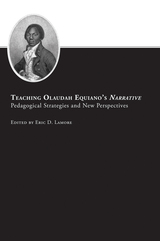 Teaching Olaudah Equiano’s Narrative: Pedagogical Strategies and New Perspectives
Eric D. Lamore
University of Tennessee Press, 2012 The Interesting Narrative of the Life of Olaudah Equiano, or Gustavus Vassa, the African. Written by Himself (1789) is one of the most frequently and heatedly discussed texts in the canon of eighteenth-century transatlantic literature written in English. Equiano’s Narrative contains an engrossing account of the author’s experiences in Africa, the Americas, and Europe as he sought freedom from bondage and became a leading figure in the abolitionist movement. While scholars have approached this sophisticated work from diverse critical and historical/biographical perspectives, there has been, until now, little written about the ways in which it can be successfully taught in the twenty-first-century classroom.
In this collection of essays, most of them never before published, sixteen teacher-scholars focus explicitly on the various classroom contexts in which the Narrative can be assigned and various pedagogical strategies that can be used to help students understand the text and its complex cultural, intellectual, literary, and historical implications. The contributors explore topics ranging from the religious dimensions of Equiano’s rhetoric and controversies about his origins, specifically whether he was actually born in Africa and endured the Middle Passage, to considerations of the Narrative’s place in American Literature survey courses and how it can be productively compared to other texts, including captivity narratives and modern works of fiction. They not only suggest an array of innovative teaching models but also offer new readings of the work that have been overlooked in Equiano studies and Slavery studies. With these two dimensions, this volume will help ensure that conversations over Equiano’s eighteenth-century autobiography remain relevant and engaging to today’s students.
ERIC D. LAMORE is an assistant professor of English at the University of Puerto Rico at Mayagüez. A contributor to The Greenwood Encyclopedia of American Poets and Poetry, he is also the coeditor, with John C. Shields, of New Essays on Phillis Wheatley.
Teaching Other Voices: Women and Religion in Early Modern Europe
Edited by Margaret L. King and Albert Rabil Jr.
University of Chicago Press, 2007 The books in The Other Voice in Early Modern Europe series chronicle the heretofore neglected stories of women between 1400 and 1700 with the aim of reviving scholarly interest in their thought as expressed in a full range of genres: treatises, orations, and history; lyric, epic, and dramatic poetry; novels and novellas; letters, biography, and autobiography; philosophy and science. Teaching Other Voices: Women and Religion in Early Modern Europe complements these rich volumes by identifying themes useful in literature, history, religion, women's studies, and introductory humanities courses. The volume's introduction, essays, and suggested course materials are intended as guides for teachers--but will serve the needs of students and scholars as well.
Teaching Peace: Students Exchange Letters with Their Teacher
Colman McCarthy
Vanderbilt University Press, 2015 To see if nonviolence could be taught, in 1982 Colman McCarthy became a volunteer teacher at one of the poorest high schools in Washington, DC. In the thirty-two years since then, he has taught peace studies courses for more than ten thousand college and high school students. Large numbers of those students have faithfully kept in touch with McCarthy, often with handwritten letters, and he has answered them with the same seriousness he brought to his columns and books. The exchanges rise to a rare kind of literature that blends personal warmth, intellectual honesty, and shared idealism.
The discussions range from peace and war to a host of other issues of social justice, such as the death penalty, human rights, poverty, the living wage, animal rights, and vegetarianism. The wide-ranging letters suggest how teacher and students co-create a world of more love and less hate.
Teaching Performance Studies
Edited by Nathan Stucky and Cynthia Wimmer. Foreword by Richard Schechner
Southern Illinois University Press, 2002 Edited by Nathan Stucky and Cynthia Wimmer, Teaching Performance Studies is the first organized treatment of performance studies theory, practice, and pedagogy. This collection of eighteen essays by leading scholars and educators reflects the emergent and contested nature of performance studies, a field that looks at the broad range of human performance from everyday conversation to formal theatre and cultural ritual. The cross-disciplinary freedom enacted by the writers suggests a new vision of performance studies—a deliberate commerce between field and classroom.
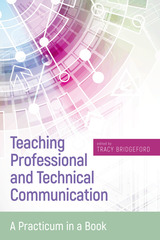 Teaching Professional and Technical Communication: A Practicum in a Book
Tracy Bridgeford
Utah State University Press, 2018 Teaching Professional and Technical Communication guides new instructors in teaching professional and technical communication (PTC). The essays in this volume provide theoretical and applied discussions about the teaching of this diverse subject, including relevant pedagogical approaches, how to apply practical aspects of PTC theory, and how to design assignments.
This practicum features chapters by prominent PTC scholars and teachers on rhetoric, style, ethics, design, usability, genre, and other central concerns of PTC programs. Each chapter includes a scenario or personal narrative of teaching a particular topic, provides a theoretical basis for interpreting the narrative, illustrates the practical aspects of the approach, describes relevant assignments, and presents a list of questions to prompt pedagogical discussions.
Teaching Professional and Technical Communication is not a compendium of best practices but instead offers a practical collection of rich, detailed narratives that show inexperienced PTC instructors how to work most effectively in the classroom.
Contributors: Pam Estes Brewer, Eva Brumberger, Dave Clark, Paul Dombrowski, James M. Dubinsky, Peter S. England, David K. Farkas, Brent Henze, Tharon W. Howard, Dan Jones, Karla Saari Kitalong, Traci Nathans-Kelly, Christine G. Nicometo, Kirk St.Amant
Teaching Queer: Radical Possibilities for Writing and Knowing
Stacey Waite
University of Pittsburgh Press, 2017 Teaching Queer looks closely at student writing, transcripts of class discussions, and teaching practices in first-year writing courses to articulate queer theories of literacy and writing instruction, while also considering the embodied actuality of being a queer teacher. Rather than positioning queerness as connected only to queer texts or queer teachers/students (as much work on queer pedagogy has done since the 1990s), this book offers writing and teaching as already queer practices, and contends that the overlap between queer theory and composition presents new possibilities for teaching writing. Teaching Queer argues for and enacts “queer forms”—non-normative and category-resistant forms of writing—those that move between the critical and the creative, the theoretical and the practical, and the queer and the often invisible normative functions of classrooms.
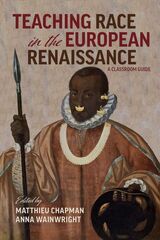 Teaching Race in the European Renaissance: A Classroom Guide
Edited by Anna Wainwright and Matthieu Chapman
Arizona Center for Medieval and Renaissance Studies, 2023 A multidisciplinary guide to classroom discussion of race in the European Renaissance.
Teaching Race in the European Renaissance: A Classroom Guide provides both educators and students the tools they need to discuss race in the European Renaissance both in its unique historical contexts and as part of a broader continuum with racial thinking today. The volume gathers scholars of the English, French, Italian, and Iberian Renaissances to provide exercises, lesson plans, methodologies, readings, and other resources designed to bring discussions of race into a broad spectrum of classes on the early modern period, from literature to art history to the history of science. This book is designed to help educators create more diverse and inclusive syllabi and curricula that engage and address a diverse, twenty-first-century student body composed of students from a growing variety of cultural, national, ethnic, and racial backgrounds. By providing clear, concise, and diverse methodologies and analytical focuses, Teaching Race in the European Renaissance: A Classroom Guide will help educators in all areas of Renaissance Studies overcome the anxiety and fear that can come with stepping outside of their expertise to engage with the topic of race, while also providing expert scholars of race in the Renaissance with new techniques and pedagogies to enhance the classroom experience of their students.
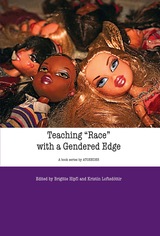 Teaching "Race" with a Gendered Edge
Brigitte Hipfl
Central European University Press, 2012 How to deal with gender, women, gender roles, feminism and gender equality in teaching practices? Following in the footsteps of the ATHENA thematic network, ATGENDER brings together specialists in women’s and gender studies, feminist research, women’s rights, gender equality and diversity. In the book series ‘Teaching with Gender’ the partners in this network have collected articles on a wide range of teaching practices in the field of gender. The books in this series address challenges and possibilities of teaching about women and gender in a wide range of educational contexts. The authors discuss pedagogical, theoretical and political dimensions of learning and teaching about women and gender. The books contain teaching material, reflections on feminist pedagogies, and practical discussions about the development of gender-sensitive curricula in specific fields. All books address the crucial aspects of education in Europe today: increasing international mobility, the growing importance of interdisciplinarity, and the many practices of life-long learning and training that take place outside the traditional programmes of higher education. These books will be indispensable tools for educators who take seriously the challenge of teaching with gender. Teaching “Race” with a Gendered Edge responds to the need to approach the idea of race from a feminist perspective. This collection of essays aims to broaden our understanding of both race and gender by highlighting the intersections and intertwinedness of race, gender, and other axes of inequality. The book also points to the importance of taking colonial legacies into account when it comes to the understanding of contemporary forms of racisms. In an increasingly globalised and interconnected world this perspective is essential for understanding the dynamics of identity politics but also for pointing towards possible ways of intervention and change.The essays in the book discuss historically contextualised examples of the intersections of race and gender from different localities in Europe and beyond and provide readers with a rich body of resources and teaching material.
Teaching Rape in the Medieval Literature Classroom: Approaches to Difficult Texts
Alison Gulley
Arc Humanities Press, 2018 <p >Teachers of medieval literature help students bridge thetemporal, contextual, and linguistic gulfs between the Middle Ages and thetwenty-first century. When episodes involving rape are thrown into the mix,that task becomes even more difficult. Students and teachers bring a variety ofexperiences to the classroom. This volume proposes ways educators can helpstudents navigate the divide between in- and out-of-class experiences and offerssuggestions for classroom activities and assignments for a range of medievaltexts, as well as insight into the concerns of students in various settings.</p>
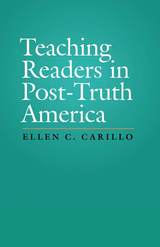 Teaching Readers in Post-Truth America
Ellen C. Carillo
Utah State University Press, 2018 Teaching Readers in Post-Truth America shows how postsecondary teachers can engage with the phenomenon of “post-truth.” Drawing on research from the fields of educational and cognitive psychology, human development, philosophy, and education, Ellen C. Carillo demonstrates that teaching critical reading is a strategic and targeted response to the current climate.
Readers in this post-truth culture are under unprecedented pressure to interpret an overwhelming quantity of texts in many forms, including speeches, news articles, position papers, and social media posts. In response, Carillo describes pedagogical interventions designed to help students become more metacognitive about their own reading and, in turn, better equipped to respond to texts in a post-truth culture.
Teaching Readers in Post-Truth America is an invaluable source of support for writing instructors striving to prepare their students to resist post-truth rhetoric and participate in an information-rich, divisive democratic society.
Teaching Religion: New Updated Edition - Sixty Years of Religious Education in England and Wales
Terence Copley
University of Exeter Press, 2008
This indispensable guide for teachers, students, and all those interested in the history and politics of pedagogy charts the course of religious education in England and Wales from 1944 to the present. The fully revised and updated second edition includes a major new chapter covering the years since the book’s original publication in 1995, and places recent changes in the religious education system in context through judicious use of documentary sources and interviews with key policy makers and curriculum practitioners. As Terence Copley engagingly explores the interaction between religious thinkers, educators, and politicians, Teaching Religion suggests that our approach to the teaching of religion within the national education system offers insight into the type of society we aspire to be.
|
|

